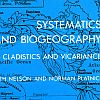| |
   
Mihaela Baroni,
Stefan Grünewald,
Vincent Moulton and
Charles Semple. Bounding the number of hybridization events for a consistent evolutionary history. In JOMB, Vol. 51(2):171-182, 2005.
Keywords: agreement forest, bound, explicit network, from rooted trees, hybridization, minimum number, phylogenetic network, phylogeny, reconstruction, SPR distance.
Note: http://www.math.canterbury.ac.nz/~c.semple/papers/BGMS05.pdf.
Toggle abstract
"Evolutionary processes such as hybridisation, lateral gene transfer, and recombination are all key factors in shaping the structure of genes and genomes. However, since such processes are not always best represented by trees, there is now considerable interest in using more general networks instead. For example, in recent studies it has been shown that networks can be used to provide lower bounds on the number of recombination events and also for the number of lateral gene transfers that took place in the evolutionary history of a set of molecular sequences. In this paper we describe the theoretical performance of some related bounds that result when merging pairs of trees into networks. © Springer-Verlag 2005."
|
|
| |
   
Jaroslaw Byrka,
Pawel Gawrychowski,
Katharina Huber and
Steven Kelk. Worst-case optimal approximation algorithms for maximizing triplet consistency within phylogenetic networks. In Journal of Discrete Algorithms, Vol. 8(1):65-75, 2010.
Keywords: approximation, explicit network, from triplets, galled tree, level k phylogenetic network, phylogenetic network, phylogeny, reconstruction.
Note: http://arxiv.org/abs/0710.3258.
Toggle abstract
"The study of phylogenetic networks is of great interest to computational evolutionary biology and numerous different types of such structures are known. This article addresses the following question concerning rooted versions of phylogenetic networks. What is the maximum value of p ∈ [0, 1] such that for every input set T of rooted triplets, there exists some network N such that at least p | T | of the triplets are consistent with N? We call an algorithm that computes such a network (where p is maximum) worst-case optimal. Here we prove that the set containing all triplets (the full triplet set) in some sense defines p. Moreover, given a network N that obtains a fraction p′ for the full triplet set (for any p′), we show how to efficiently modify N to obtain a fraction ≥ p′ for any given triplet set T. We demonstrate the power of this insight by presenting a worst-case optimal result for level-1 phylogenetic networks improving considerably upon the 5/12 fraction obtained recently by Jansson, Nguyen and Sung. For level-2 phylogenetic networks we show that p ≥ 0.61. We emphasize that, because we are taking | T | as a (trivial) upper bound on the size of an optimal solution for each specific input T, the results in this article do not exclude the existence of approximation algorithms that achieve approximation ratio better than p. Finally, we note that all the results in this article also apply to weighted triplet sets. © 2009 Elsevier B.V. All rights reserved."
|
|
| |
 
Magnus Bordewich and
Charles Semple. Computing the minimum number of hybridization events for a consistent evolutionary history. In DAM, Vol. 155:914-918, 2007.
Keywords: agreement forest, approximation, APX hard, explicit network, from rooted trees, hybridization, inapproximability, NP complete, phylogenetic network, phylogeny, SPR distance.
Note: http://www.math.canterbury.ac.nz/~c.semple/papers/BS06a.pdf.
|
|
| |
  
Mihaela Baroni,
Charles Semple and
Mike Steel. A framework for representing reticulate evolution. In ACOM, Vol. 8:398-401, 2004.
Keywords: explicit network, from clusters, hybridization, minimum number, phylogenetic network, phylogeny, reconstruction, regular network, SPR distance.
Note: http://www.math.canterbury.ac.nz/~c.semple/papers/BSS04.pdf.
Toggle abstract
"Acyclic directed graphs (ADGs) are increasingly being viewed as more appropriate for representing certain evolutionary relationships, particularly in biology, than rooted trees. In this paper, we develop a framework for the analysis of these graphs which we call hybrid phylogenies. We are particularly interested in the problem whereby one is given a set of phylogenetic trees and wishes to determine a hybrid phylogeny that 'embeds' each of these trees and which requires the smallest number of hybridisation events. We show that this quantity can be greatly reduced if additional species are involved, and investigate other combinatorial aspects of this and related questions."
|
|
| |
   
Ho-Leung Chan,
Jesper Jansson,
Tak-Wah Lam and
Siu-Ming Yiu. Reconstructing an Ultrametric Galled Phylogenetic Network from a Distance Matrix. In JBCB, Vol. 4(4):807-832, 2006.
Keywords: explicit network, from distances, galled tree, phylogenetic network, phylogeny, polynomial, reconstruction.
Note: http://www.df.lth.se/~jj/Publications/dist_ugn7_JBCB2006.pdf.
Toggle abstract
"Given a distance matrix M that specifies the pairwise evolutionary distances between n species, the phylogenetic tree reconstruction problem asks for an edge-weighted phylogenetic tree that satisfies M, if one exists. We study some extensions of this problem to rooted phylogenetic networks. Our main result is an O(n2 log n)-time algorithm for determining whether there is an ultrametric galled network that satisfies M, and if so, constructing one. In fact, if such an ultrametric galled network exists, our algorithm is guaranteed to construct one containing the minimum possible number of nodes with more than one parent (hybrid nodes). We also prove that finding a largest possible submatrix M′ of M such that there exists an ultrametric galled network that satisfies M′ is NP-hard. Furthermore, we show that given an incomplete distance matrix (i.e. where some matrix entries are missing), it is also NP-hard to determine whether there exists an ultrametric galled network which satisfies it. © 2006 Imperial College Press."
|
|
| |
  
Gabriel Cardona,
Francesc Rosselló and
Gabriel Valiente. Comparison of tree-child phylogenetic networks. In TCBB, Vol. 6(4):552-569, 2009.
Keywords: explicit network, phylogenetic network, phylogeny, Program Bio PhyloNetwork, Program PhyloNetwork, tree sibling network, tree-child network.
Note: http://arxiv.org/abs/0708.3499.
Toggle abstract
"Phylogenetic networks are a generalization of phylogenetic trees that allow for the representation of nontreelike evolutionary events, like recombination, hybridization, or lateral gene transfer. While much progress has been made to find practical algorithms for reconstructing a phylogenetic network from a set of sequences, all attempts to endorse a class of phylogenetic networks (strictly extending the class of phylogenetic trees) with a well-founded distance measure have, to the best of our knowledge and with the only exception of the bipartition distance on regular networks, failed so far. In this paper, we present and study a new meaningful class of phylogenetic networks, called tree-child phylogenetic networks, and we provide an injective representation of these networks as multisets of vectors of natural numbers, their path multiplicity vectors. We then use this representation to define a distance on this class that extends the well-known Robinson-Foulds distance for phylogenetic trees and to give an alignment method for pairs of networks in this class. Simple polynomial algorithms for reconstructing a tree-child phylogenetic network from its path multiplicity vectors, for computing the distance between two tree-child phylogenetic networks and for aligning a pair of tree-child phylogenetic networks, are provided. They have been implemented as a Perl package and a Java applet, which can be found at http://bioinfo.uib.es/~recerca/ phylonetworks/mudistance/. © 2009 IEEE."
|
|
| |
 
Olivier Gauthier and
François-Joseph Lapointe. Hybrids and Phylogenetics Revisited: A Statistical Test of Hybridization Using Quartets. In Systematic Botany, Vol. 32(1):8-15, 2007.
Keywords: explicit network, from quartets, hybridization, phylogenetic network, phylogeny, reconstruction, reticulogram, split decomposition.
Note: http://dx.doi.org/10.1600/036364407780360238.
Toggle abstract
"The occurrence of reticulations in the evolutionary history of species poses serious challenges for all modern practitioners of phylogenetic analysis. Such events, including hybridization, introgression, and lateral gene transfer, lead to evolutionary histories that cannot be adequately represented in the form of phylogenetic trees. Although numerous methods that allow for the reconstruction of phylogenetic networks have been proposed in recent years, the detection of reticulations still remains problematic. In this paper we present a Hybrid Detection Criterion (HDC) along with a statistical procedure that allows for the identification of hybrid taxa. The test assesses whether a putative hybrid is consistently intermediate between its postulated parents, with respect to the other taxa. The performance of the statistical method is evaluated using known hybrids of the genus Aphelandra (Acanthaceae) using two network methods: reticulograms and split decomposition graphs. Our results indicate that the HDC test is reliable when used jointly with split decomposition. On the other hand, the test lacks power and provides misleading results when using reticulograms. We then show how the procedure can be used as a tool to identify putative hybrids. © Copyright 2007 by the American Society of Plant Taxonomists."
|
|
| |
 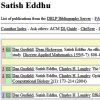 
Dan Gusfield,
Satish Eddhu and
Charles Langley. Optimal, Efficient Reconstruction of Phylogenetic Networks with Constrained Recombination. In JBCB, Vol. 2(1):173-213, 2004.
Keywords: explicit network, from sequences, galled tree, phylogenetic network, phylogeny, recombination, reconstruction.
Note: http://wwwcsif.cs.ucdavis.edu/~gusfield/exfinalrec.pdf.
Toggle abstract
"A phylogenetic network is a generalization of a phylogenetic tree, allowing structural properties that are not tree-like. In a seminal paper, Wang et al.1 studied the problem of constructing a phylogenetic network, allowing recombination between sequences, with the constraint that the resulting cycles must be disjoint. We call such a phylogenetic network a "galled-tree". They gave a polynomial-time algorithm that was intended to determine whether or not a set of sequences could be generated on galled-tree. Unfortunately, the algorithm by Wang et al.1 is incomplete and does not constitute a necessary test for the existence of a galled-tree for the data. In this paper, we completely solve the problem. Moreover, we prove that if there is a galled-tree, then the one produced by our algorithm minimizes the number of recombinations over all phylogenetic networks for the data, even allowing multiple-crossover recombinations. We also prove that when there is a galled-tree for the data, the galled-tree minimizing the number of recombinations is "essentially unique" . We. also note two additional results: first, any set of sequences that can be derived on a galled tree can be derived on a true tree (without recombination cycles), where at most one back mutation per site is allowed; second, the site compatibility problem (which is NP-hard in general) can be solved in polynomial time for any set of sequences that can be derived on a galled tree. Perhaps more important than the specific results about galled-trees, we introduce an approach that can be used to study recombination in general phylogenetic networks. This paper greatly extends the conference version that appears in an earlier work.8 PowerPoint slides of the conference talk can be found at our website. © Imperial College Press."
|
|
| |
  
Dan Gusfield,
Satish Eddhu and
Charles Langley. The fine structure of galls in phylogenetic networks. In INCOMP, Vol. 16(4):459-469, 2004.
Keywords: explicit network, from sequences, galled tree, phylogenetic network, phylogeny, reconstruction.
Note: http://wwwcsif.cs.ucdavis.edu/~gusfield/informs.pdf.
Toggle abstract
"A phylogenetic network is a generalization of a phylogenetic tree, allowing properties that are not tree-like. With the growth of genomic data, much of which does not fit ideal tree models, there is greater need to understand the algorithmics and combinatorics of phylogenetic networks (Posada and Crandall 2001, Schierup and Hein 2000). Wang et al. (2001) studied the problem of constructing a phylogenetic network for a set of n binary sequences derived from the all-zero ancestral sequence, when each site in the sequence can mutate from zero to one at most once in the network, and recombination between sequences is allowed. They showed that the problem of minimizing the number of recombinations in such networks is NP-hard, but introduced a special case of the problem, i.e., to determine whether the sequences could be derived on a phylogenetic network where the recombination cycles are node-disjoint. Wang et al. (2001) provide a sufficient, but not a necessary test, for such solutions. Gusfield et al. (2003, 2004) gave a polynomial-time algorithm that is both a necessary and sufficient test. In this paper, we study in much more detail the fine combinatorial structure of node-disjoint cycles in phylogenetic networks, both for purposes of insight into phylogenetic networks and to speed up parts of the previous algorithm. We explicitly characterize all the ways in which mutations can be arranged on a disjoint cycle, and prove a strong necessary condition for a set of mutations to be on a disjoint cycle. The main contribution here is to show how structure in the phylogenetic network is reflected in the structure of an efficiently-computable graph, called the conflict graph. The success of this approach suggests that additional insight into the structure of phylogenetic networks can be obtained by exploring structural properties of the conflict graph."
|
|
| |
|
| |

Jotun Hein. A heuristic method to reconstruct the history of sequences subject to recombination. In JME, Vol. 36(4):396-405, 1993.
Keywords: explicit network, from sequences, heuristic, parsimony, phylogenetic network, phylogeny, Program RecPars, recombination, recombination detection, software.
Note: http://dx.doi.org/10.1007/BF00182187.
|
|
| |
   
Katharina Huber,
Bengt Oxelman,
Martin Lott and
Vincent Moulton. Reconstructing the Evolutionary History of Polyploids from Multilabeled Trees. In MBE, Vol. 23(9):1784-1791, 2007.
Keywords: duplication, explicit network, from multilabeled tree, from trees, phylogenetic network, phylogeny, Program PADRE, reconstruction, software.
Note: http://mbe.oxfordjournals.org/cgi/content/full/23/9/1784.
Toggle abstract
"In recent studies, phylogenetic networks have been derived from so-called multilabeled trees in order to understand the origins of certain polyploids. Although the trees used in these studies were constructed using sophisticated techniques in phylogenetic analysis, the presented networks were inferred using ad hoc arguments that cannot be easily extended to larger, more complicated examples. In this paper, we present a general method for constructing such networks, which takes as input a multilabeled phylogenetic tree and outputs a phylogenetic network with certain desirable properties. To illustrate the applicability of our method, we discuss its use in reconstructing the evolutionary history of plant allopolyploids. We conclude with a discussion concerning possible future directions. The network construction method has been implemented and is freely available for use from http://www.uea.ac.uk/ ∼a043878/padre.html. © The Author 2006. Published by Oxford University Press on behalf of the Society for Molecular Biology and Evolution. All rights reserved."
|
|
| |
 
Vincent Moulton and
Katharina Huber. Phylogenetic networks from multi-labelled trees. In JOMB, Vol. 52(5):613-632, 2006.
Keywords: duplication, explicit network, from multilabeled tree, phylogenetic network, phylogeny, Program PADRE, reconstruction.
Note: http://www.uea.ac.uk/~a043878/jmb.pdf.
Toggle abstract
"It is now quite well accepted that the evolutionary past of certain species is better represented by phylogenetic networks as opposed to trees. For example, polyploids are typically thought to have resulted through hybridization and duplication, processes that are probably not best represented as bifurcating speciation events. Based on the knowledge of a multi-labelled tree relating collection of polyploids, we present a canonical construction of a phylogenetic network that exhibits the tree. In addition, we prove that the resulting network is in some well-defined sense a minimal network having this property. © Springer-Verlag 2006."
|
|
| |
 
Jesper Jansson and
Wing-Kin Sung. Inferring a level-1 phylogenetic network from a dense set of rooted triplets. In TCS, Vol. 363(1):60-68, 2006.
Keywords: explicit network, from triplets, galled tree, level k phylogenetic network, phylogenetic network, phylogeny, polynomial, reconstruction.
Note: http://www.df.lth.se/~jj/Publications/ipnrt8_TCS2006.pdf.
Toggle abstract
"We consider the following problem: Given a set T of rooted triplets with leaf set L, determine whether there exists a phylogenetic network consistent with T, and if so, construct one. We show that if no restrictions are placed on the hybrid nodes in the solution, the problem is trivially solved in polynomial time by a simple sorting network-based construction. For the more interesting (and biologically more motivated) case where the solution is required to be a level-1 phylogenetic network, we present an algorithm solving the problem in O (| T |2) time when T is dense, i.e., when T contains at least one rooted triplet for each cardinality three subset of L. We also give an O (| T |5 / 3)-time algorithm for finding the set of all phylogenetic networks having a single hybrid node attached to exactly one leaf (and having no other hybrid nodes) that are consistent with a given dense set of rooted triplets. © 2006 Elsevier B.V. All rights reserved."
|
|
| |
  
Jesper Jansson,
Nguyen Bao Nguyen and
Wing-Kin Sung. Algorithms for Combining Rooted Triplets into a Galled Phylogenetic Network. In SICOMP, Vol. 35(5):1098-1121, 2006.
Keywords: approximation, explicit network, from triplets, galled tree, phylogenetic network, phylogeny, polynomial, reconstruction.
Note: http://www.df.lth.se/~jj/Publications/triplets_to_gn7_SICOMP2006.pdf.
Toggle abstract
"This paper considers the problem of determining whether a given set Τ of rooted triplets can be merged without conflicts into a galled phylogenetic network and, if so, constructing such a network. When the input Τ is dense, we solve the problem in O(|Τ|) time, which is optimal since the size of the input is Θ(|Τ|). In comparison, the previously fastest algorithm for this problem runs in O(|Τ|2) time. We also develop an optimal O(|Τ|)-time algorithm for enumerating all simple phylogenetic networks leaf-labeled by L that are consistent with Τ, where L is the set of leaf labels in Τ, which is used by our main algorithm. Next, we prove that the problem becomes NP-hard if extended to nondense inputs, even for the special case of simple phylogenetic networks. We also show that for every positive integer n, there exists some set Τ of rooted triplets on n leaves such that any galled network can be consistent with at most 0.4883 ·|Τ| of the rooted triplets in Τ. On the other hand, we provide a polynomial-time approximation algorithm that always outputs a galled network consistent with at least a factor of 5/12 (> 0.4166) of the rooted triplets in Τ. © 2006 Society for Industrial and Applied Mathematics."
|
|
| |
   
Guohua Jin,
Luay Nakhleh,
Sagi Snir and
Tamir Tuller. Maximum Likelihood of Phylogenetic Networks. In BIO, Vol. 22(21):2604-2611, 2006.
Keywords: explicit network, likelihood, phylogenetic network, phylogeny, Program Nepal, reconstruction.
Note: http://www.cs.rice.edu/~nakhleh/Papers/NetworksML06.pdf, supplementary material: http://www.cs.rice.edu/~nakhleh/Papers/Supp-ML.pdf.
|
|
| |
|
| |
   
Cam Thach Nguyen,
Nguyen Bao Nguyen,
Wing-Kin Sung and
Louxin Zhang. Reconstructing Recombination Network from Sequence Data: The Small Parsimony Problem. In TCBB, Vol. 4(3):394-402, 2007.
Keywords: explicit network, from sequences, labeling, NP complete, parsimony, phylogenetic network, phylogeny.
Note: http://www.cs.washington.edu/homes/ncthach/Papers/TCBB2007.pdf.
|
|
| |
|
| |
|
| |
|
| |
|
| |
|
| |
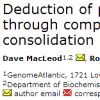 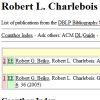  
Dave MacLeod,
Robert L. Charlebois,
W. Ford Doolittle and
Eric Bapteste. Deduction of probable events of lateral gene transfer through comparison of phylogenetic trees by recursive consolidation and rearrangement. In BMCEB, Vol. 5(27), 2005.
Keywords: explicit network, from rooted trees, lateral gene transfer, phylogenetic network, phylogeny, Program HorizStory, reconstruction, software.
Note: http://dx.doi.org/10.1186/1471-2148-5-27.
Toggle abstract
"Background: When organismal phylogenies based on sequences of single marker genes are poorly resolved, a logical approach is to add more markers, on the assumption that weak but congruent phylogenetic signal will be reinforced in such multigene trees. Such approaches are valid only when the several markers indeed have identical phylogenies, an issue which many multigene methods (such as the use of concatenated gene sequences or the assembly of supertrees) do not directly address. Indeed, even when the true history is a mixture of vertical descent for some genes and lateral gene transfer (LGT) for others, such methods produce unique topologies. Results: We have developed software that aims to extract evidence for vertical and lateral inheritance from a set of gene trees compared against an arbitrary reference tree. This evidence is then displayed as a synthesis showing support over the tree for vertical inheritance, overlaid with explicit lateral gene transfer (LGT) events inferred to have occurred over the history of the tree. Like splits-tree methods, one can thus identify nodes at which conflict occurs. Additionally one can make reasonable inferences about vertical and lateral signal, assigning putative donors and recipients. Conclusion: A tool such as ours can serve to explore the reticulated dimensionality of molecular evolution, by dissecting vertical and lateral inheritance at high resolution. By this, we mean that individual nodes can be examined not only for congruence, but also for coherence in light of LGT. We assert that our tools will facilitate the comparison of phylogenetic trees, and the interpretation of conflicting data. © 2005 MacLeod et al; licensee BioMed Central Ltd."
|
|
| |
   
Dan Gusfield,
Vikas Bansal,
Vineet Bafna and
Yun S. Song. A Decomposition Theory for Phylogenetic Networks and Incompatible Characters. In JCB, Vol. 14(10):1247-1272, 2007.
Keywords: explicit network, from sequences, galled tree, phylogenetic network, phylogeny, Program Beagle, Program GalledTree, recombination, reconstruction, software.
Note: http://www.eecs.berkeley.edu/~yss/Pub/decomposition.pdf.
|
|
| |
  
Leo van Iersel,
Steven Kelk and
Matthias Mnich. Uniqueness, intractability and exact algorithms: reflections on level-k phylogenetic networks. In JBCB, Vol. 7(4):597-623, 2009.
Keywords: explicit network, from triplets, galled tree, level k phylogenetic network, NP complete, phylogenetic network, phylogeny, reconstruction, uniqueness.
Note: http://arxiv.org/pdf/0712.2932v2.
|
|
| |
 
Tobias Kloepper and
Daniel H. Huson. Drawing explicit phylogenetic networks and their integration into SplitsTree. In BMCEB, Vol. 8(22), 2008.
Keywords: explicit network, phylogenetic network, phylogeny, Program SplitsTree, software, split network, visualization.
Note: http://dx.doi.org/10.1186/1471-2148-8-22.
Toggle abstract
"Background. SplitsTree provides a framework for the calculation of phylogenetic trees and networks. It contains a wide variety of methods for the import/export, calculation and visualization of phylogenetic information. The software is developed in Java and implements a command line tool as well as a graphical user interface. Results. In this article, we present solutions to two important problems in the field of phylogenetic networks. The first problem is the visualization of explicit phylogenetic networks. To solve this, we present a modified version of the equal angle algorithm that naturally integrates reticulations into the layout process and thus leads to an appealing visualization of these networks. The second problem is the availability of explicit phylogenetic network methods for the general user. To advance the usage of explicit phylogenetic networks by biologists further, we present an extension to the SplitsTree framework that integrates these networks. By addressing these two problems, SplitsTree is among the first programs that incorporates implicit and explicit network methods together with standard phylogenetic tree methods in a graphical user interface environment. Conclusion. In this article, we presented an extension of SplitsTree 4 that incorporates explicit phylogenetic networks. The extension provides a set of core classes to handle explicit phylogenetic networks and a visualization of these networks. © 2008 Kloepper and Huson; licensee BioMed Central Ltd."
|
|
| |

Daniel H. Huson. Drawing Rooted Phylogenetic Networks. In TCBB, Vol. 6(1):103-109, 2009.
Keywords: explicit network, phylogenetic network, phylogeny, Program Dendroscope, Program SplitsTree, visualization.
Note: http://dx.doi.org/10.1109/TCBB.2008.58.
Toggle abstract
"The evolutionary history of a collection of species is usually represented by a phylogenetic tree. Sometimes, phylogenetic networks are used as a means of representing reticulate evolution or of showing uncertainty and incompatibilities in evolutionary datasets. This is often done using unrooted phylogenetic networks such as split networks, due in part, to the availability of software (SplitsTree) for their computation and visualization. In this paper we discuss the problem of drawing rooted phylogenetic networks as cladograms or phylograms in a number of different views that are commonly used for rooted trees. Implementations of the algorithms are available in new releases of the Dendroscope and SplitsTree programs. © 2006 IEEE."
|
|
| |
   
Gabriel Cardona,
Mercè Llabrés,
Francesc Rosselló and
Gabriel Valiente. Metrics for phylogenetic networks I: Generalizations of the Robinson-Foulds metric. In TCBB, Vol. 6(1):46-61, 2009.
Keywords: distance between networks, explicit network, phylogenetic network, phylogeny, time consistent network, tree-child network, tripartition distance.
Note: http://dx.doi.org/10.1109/TCBB.2008.70.
Toggle abstract
"The assessment of phylogenetic network reconstruction methods requires the ability to compare phylogenetic networks. This is the first in a series of papers devoted to the analysis and comparison of metrics for tree-child time consistent phylogenetic networks on the same set of taxa. In this paper, we study three metrics that have already been introduced in the literature: the Robinson-Foulds distance, the tripartitions distance and the $mu$-distance. They generalize to networks the classical Robinson-Foulds or partition distance for phylogenetic trees. We analyze the behavior of these metrics by studying their least and largest values and when they achieve them. As a by-product of this study, we obtain tight bounds on the size of a tree-child time consistent phylogenetic network. © 2006 IEEE."
|
|
| |
   
Barbara R. Holland,
Steffi Benthin,
Peter J. Lockhart,
Vincent Moulton and
Katharina Huber. Using supernetworks to distinguish hybridization from lineage-sorting. In BMCEB, Vol. 8(202), 2008.
Keywords: explicit network, from unrooted trees, hybridization, lineage sorting, phylogenetic network, phylogeny, reconstruction, supernetwork.
Note: http://dx.doi.org/10.1186/1471-2148-8-202.
Toggle abstract
"Background. A simple and widely used approach for detecting hybridization in phylogenies is to reconstruct gene trees from independent gene loci, and to look for gene tree incongruence. However, this approach may be confounded by factors such as poor taxon-sampling and/or incomplete lineage-sorting. Results. Using coalescent simulations, we investigated the potential of supernetwork methods to differentiate between gene tree incongruence arising from taxon sampling and incomplete lineage-sorting as opposed to hybridization. For few hybridization events, a large number of independent loci, and well-sampled taxa across these loci, we found that it was possible to distinguish incomplete lineage-sorting from hybridization using the filtered Z-closure and Q-imputation supernetwork methods. Moreover, we found that the choice of supernetwork method was less important than the choice of filtering, and that count-based filtering was the most effective filtering technique. Conclusion. Filtered supernetworks provide a tool for detecting and identifying hybridization events in phylogenies, a tool that should become increasingly useful in light of current genome sequencing initiatives and the ease with which large numbers of independent gene loci can be determined using new generation sequencing technologies. © 2008 Holland et al; licensee BioMed Central Ltd."
|
|
| |
  
Miguel Arenas,
Gabriel Valiente and
David Posada. Characterization of reticulate networks based on the coalescent with recombination. In MBE, Vol. 25(12):2517-2520, 2008.
Keywords: coalescent, evaluation, explicit network, galled tree, phylogenetic network, phylogeny, Program Recodon, regular network, simulation, tree sibling network, tree-child network.
Note: http://dx.doi.org/10.1093/molbev/msn219.
Toggle abstract
"Phylogenetic networks aim to represent the evolutionary history of taxa. Within these, reticulate networks are explicitly able to accommodate evolutionary events like recombination, hybridization, or lateral gene transfer. Although several metrics exist to compare phylogenetic networks, they make several assumptions regarding the nature of the networks that are not likely to be fulfilled by the evolutionary process. In order to characterize the potential disagreement between the algorithms and the biology, we have used the coalescent with recombination to build the type of networks produced by reticulate evolution and classified them as regular, tree sibling, tree child, or galled trees. We show that, as expected, the complexity of these reticulate networks is a function of the population recombination rate. At small recombination rates, most of the networks produced are already more complex than regular or tree sibling networks, whereas with moderate and large recombination rates, no network fit into any of the standard classes. We conclude that new metrics still need to be devised in order to properly compare two phylogenetic networks that have arisen from reticulating evolutionary process. © 2008 The Authors."
|
|
| |
  
Gabriel Cardona,
Francesc Rosselló and
Gabriel Valiente. Extended Newick: It is Time for a Standard Representation. In BMCB, Vol. 9:532, 2008.
Keywords: evaluation, explicit network, phylogenetic network, Program Bio PhyloNetwork, Program Dendroscope, Program NetGen, Program PhyloNet, Program SplitsTree, Program TCS, visualization.
Note: http://bioinfo.uib.es/media/uploaded/bmc-2008-enewick-sub.pdf.
|
|
| |
 
Supriya Munshaw and
Thomas B. Kepler. An Information-Theoretic Method for the Treatment of Plural Ancestry in Phylogenetics. In MBE, Vol. 25(6):1199-1208, 2008.
Keywords: explicit network, from sequences, heuristic, phylogenetic network, reconstruction, simulated annealing, software.
Note: http://dx.doi.org/10.1093/molbev/msn066.
Toggle abstract
"In the presence of recombination and gene conversion, a given genomic segment may inherit information from 2 distinct immediate ancestors. The importance of this type of molecular inheritance has become increasingly clear over the years, and the potential for erroneous inference when it is not accounted for in the statistical model is well documented. Yet, the inclusion of plural ancestry (PA) in phylogenetic analysis is still not routine. This omission is due to the greater difficulty of phylogenetic inference on general acyclic graphs compared that on with trees and the accompanying computational burden. We have developed a technique for phylogenetic inference in the presence of PA based on the principle of minimum description length, which assigns a cost - the description length - to each network topology given the observed sequence data. The description length combines the cost of poor data fit and model complexity in terms of information. This device allows us to search through network topologies to minimize the total description length. By comparing the best models obtained with and without PA, one can determine whether or not recombination has played an active role in the evolution of the genes under investigation, identify those genes that appear to be mosaic, and infer the phylogenetic network that best represents the history of the alignment. We show that the method performs well on simulated data and demonstrate its application on HIV env gene sequence data from 8 human subjects. The software implementation of the method is available upon request. © The Author 2008. Published by Oxford University Press on behalf of the Society for Molecular Biology and Evolution. All rights reserved."
|
|
| |
|
| |
   
Galina Glazko,
Vladimir Makarenkov,
Jing Liu and
Arcady Mushegian. Evolutionary history of bacteriophages with double-stranded DNA genomes. In Biology Direct, Vol. 2(36), 2007.
Keywords: explicit network, from sequences, phylogenetic network, phylogeny, Program T REX.
Note: http://dx.doi.org/10.1186/1745-6150-2-36.
Toggle abstract
"Background: Reconstruction of evolutionary history of bacteriophages is a difficult problem because of fast sequence drift and lack of omnipresent genes in phage genomes. Moreover, losses and recombinational exchanges of genes are so pervasive in phages that the plausibility of phylogenetic inference in phage kingdom has been questioned. Results: We compiled the profiles of presence and absence of 803 orthologous genes in 158 completely sequenced phages with double-stranded DNA genomes and used these gene content vectors to infer the evolutionary history of phages. There were 18 well-supported clades, mostly corresponding to accepted genera, but in some cases appearing to define new taxonomic groups. Conflicts between this phylogeny and trees constructed from sequence alignments of phage proteins were exploited to infer 294 specific acts of intergenome gene transfer. Conclusion: A notoriously reticulate evolutionary history of fast-evolving phages can be reconstructed in considerable detail by quantitative comparative genomics. © 2007 Glazko et al; licensee BioMed Central Ltd."
|
|
| |
 
Roderic D.M. Page and
Michael A. Charleston. Trees within trees: phylogeny and historical associations. In TEE, Vol. 13(9):356-359, 1998.
Keywords: duplication, explicit network, from rooted trees, from species tree, lateral gene transfer, phylogenetic network, phylogeny, reconstruction, survey.
Note: http://taxonomy.zoology.gla.ac.uk/rod/papers/tree.pdf.
|
|
| |
   
Cuong Than,
Derek Ruths,
Hideki Innan and
Luay Nakhleh. Confounding Factors in HGT Detection: Statistical Error, Coalescent Effects, and Multiple Solutions. In JCB, Vol. 14(4):517-535, 2007.
Keywords: counting, explicit network, from rooted trees, from species tree, lateral gene transfer, phylogenetic network, phylogeny, Program LatTrans, Program PhyloNet.
Note: http://www.cs.rice.edu/~nakhleh/Papers/recombcg06-jcb.pdf.
|
|
| |
  
Bin Ma,
Lusheng Wang and
Ming Li. Fixed topology alignment with recombination. In DAM, Vol. 104:281-300, 2000.
Keywords: approximation, explicit network, from network, from sequences, galled tree, inapproximability, phylogenetic network, phylogeny, recombination.
Note: http://citeseerx.ist.psu.edu/viewdoc/summary?doi=10.1.1.40.7759.
Toggle abstract
"Background: Reticulate events play an important role in determining evolutionary relationships. The problem of computing the minimum number of such events to explain discordance between two phylogenetic trees is a hard computational problem. Even for binary trees, exact solvers struggle to solve instances with reticulation number larger than 40-50.Results: Here we present CycleKiller and NonbinaryCycleKiller, the first methods to produce solutions verifiably close to optimality for instances with hundreds or even thousands of reticulations.Conclusions: Using simulations, we demonstrate that these algorithms run quickly for large and difficult instances, producing solutions that are very close to optimality. As a spin-off from our simulations we also present TerminusEst, which is the fastest exact method currently available that can handle nonbinary trees: this is used to measure the accuracy of the NonbinaryCycleKiller algorithm. All three methods are based on extensions of previous theoretical work (SIDMA 26(4):1635-1656, TCBB 10(1):18-25, SIDMA 28(1):49-66) and are publicly available. We also apply our methods to real data. © 2014 van Iersel et al.; licensee BioMed Central Ltd."
|
|
| |
 
Sagi Snir and
Tamir Tuller. The NET-HMM approach: Phylogenetic Network Inference by Combining Maximum Likelihood and Hidden Markov Models. In JBCB, Vol. 7(4):625-644, 2009.
Keywords: explicit network, from sequences, HMM, lateral gene transfer, likelihood, phylogenetic network, phylogeny, statistical model.
Note: http://research.haifa.ac.il/~ssagi/published%20papers/Snir-NET-HMM-JBCB-2009.pdf.
Toggle abstract
"Horizontal gene transfer (HGT) is the event of transferring genetic material from one lineage in the evolutionary tree to a different lineage. HGT plays a major role in bacterial genome diversification and is a significant mechanism by which bacteria develop resistance to antibiotics. Although the prevailing assumption is of complete HGT, cases of partial HGT (which are also named chimeric HGT) where only part of a gene is horizontally transferred, have also been reported, albeit less frequently. In this work we suggest a new probabilistic model, the NET-HMM, for analyzing and modeling phylogenetic networks. This new model captures the biologically realistic assumption that neighboring sites of DNA or amino acid sequences are not independent, which increases the accuracy of the inference. The model describes the phylogenetic network as a Hidden Markov Model (HMM), where each hidden state is related to one of the network's trees. One of the advantages of the NET-HMM is its ability to infer partial HGT as well as complete HGT. We describe the properties of the NET-HMM, devise efficient algorithms for solving a set of problems related to it, and implement them in software. We also provide a novel complementary significance test for evaluating the fitness of a model (NET-HMM) to a given dataset. Using NET-HMM, we are able to answer interesting biological questions, such as inferring the length of partial HGT's and the affected nucleotides in the genomic sequences, as well as inferring the exact location of HGT events along the tree branches. These advantages are demonstrated through the analysis of synthetical inputs and three different biological inputs. © 2009 Imperial College Press."
|
|
| |
 
Johannes Fischer and
Daniel H. Huson. New Common Ancestor Problems in Trees and Directed Acyclic Graphs. In IPL, Vol. 110(8-9):331-335, 2010.
Keywords: explicit network, phylogenetic network, polynomial.
Note: http://www-ab.informatik.uni-tuebingen.de/people/fischer/lsa.pdf.
Toggle abstract
"We derive a new generalization of lowest common ancestors (LCAs) in dags, called the lowest single common ancestor (LSCA). We show how to preprocess a static dag in linear time such that subsequent LSCA-queries can be answered in constant time. The size is linear in the number of nodes. We also consider a "fuzzy" variant of LSCA that allows to compute a node that is only an LSCA of a given percentage of the query nodes. The space and construction time of our scheme for fuzzy LSCAs is linear, whereas the query time has a sub-logarithmic slow-down. This "fuzzy" algorithm is also applicable to LCAs in trees, with the same complexities. © 2010 Elsevier B.V. All rights reserved."
|
|
| |

Stephen J. Willson. Regular Networks Can Be Uniquely Constructed from Their Trees. In TCBB, Vol. 8(3):785-796, 2010.
Keywords: explicit network, from rooted trees, phylogenetic network, phylogeny, reconstruction, regular network.
Note: http://www.public.iastate.edu/~swillson/RegularNetsFromTrees5.pdf.
Toggle abstract
"A rooted acyclic digraph N with labeled leaves displays a tree T when there exists a way to select a unique parent of each hybrid vertex resulting in the tree T. Let Tr(N) denote the set of all trees displayed by the network N. In general, there may be many other networks M, such that Tr(M) = Tr(N). A network is regular if it is isomorphic with its cover digraph. If N is regular and D is a collection of trees displayed by N, this paper studies some procedures to try to reconstruct N given D. If the input is D=Tr(N), one procedure is described, which will reconstruct N. Hence, if N and M are regular networks and Tr(N) = Tr(M), it follows that N = M, proving that a regular network is uniquely determined by its displayed trees. If D is a (usually very much smaller) collection of displayed trees that satisfies certain hypotheses, modifications of the procedure will still reconstruct N given D. © 2011 IEEE."
|
|
| |
   
Martin Lott,
Andreas Spillner,
Katharina Huber and
Vincent Moulton. PADRE: A Package for Analyzing and Displaying Reticulate Evolution. In BIO, Vol. 25(9):1199-1200, 2009.
Keywords: duplication, explicit network, from multilabeled tree, phylogenetic network, phylogeny, Program PADRE, reconstruction, software.
Note: http://dx.doi.org/10.1093/bioinformatics/btp133.
Toggle abstract
"Recent advances in gene sequencing for polyploid species, coupled with standard phylogenetic tree reconstruction, leads to gene trees in which the same species can label several leaves. Such multi-labeled trees are then used to reconstruct the evolutionary history of the polyploid species in question. However, this reconstruction process requires new techniques that are not available in current phylogenetic software packages. Here, we describe the software package PADRE (Package for Analyzing and Displaying Reticulate Evolution) that implements such techniques, allowing the reconstruction of complex evolutionary histories for polyploids in the form of phylogenetic networks. © The Author 2009. Published by Oxford University Press. All rights reserved."
|
|
| |
|
| |
 
Philippe Gambette and
Katharina Huber. On Encodings of Phylogenetic Networks of Bounded Level. In JOMB, Vol. 65(1):157-180, 2012.
Keywords: characterization, explicit network, from clusters, from rooted trees, from triplets, galled tree, identifiability, level k phylogenetic network, phylogenetic network, uniqueness, weak hierarchy.
Note: http://hal.archives-ouvertes.fr/hal-00609130/en/.
Toggle abstract
"Phylogenetic networks have now joined phylogenetic trees in the center of phylogenetics research. Like phylogenetic trees, such networks canonically induce collections of phylogenetic trees, clusters, and triplets, respectively. Thus it is not surprising that many network approaches aim to reconstruct a phylogenetic network from such collections. Related to the well-studied perfect phylogeny problem, the following question is of fundamental importance in this context: When does one of the above collections encode (i. e. uniquely describe) the network that induces it? For the large class of level-1 (phylogenetic) networks we characterize those level-1 networks for which an encoding in terms of one (or equivalently all) of the above collections exists. In addition, we show that three known distance measures for comparing phylogenetic networks are in fact metrics on the resulting subclass and give the diameter for two of them. Finally, we investigate the related concept of indistinguishability and also show that many properties enjoyed by level-1 networks are not satisfied by networks of higher level. © 2011 Springer-Verlag."
|
|
| |
   
Katharina Huber,
Leo van Iersel,
Steven Kelk and
Radoslaw Suchecki. A Practical Algorithm for Reconstructing Level-1 Phylogenetic Networks. In TCBB, Vol. 8(3):607-620, 2011.
Keywords: explicit network, from triplets, galled tree, generation, heuristic, phylogenetic network, phylogeny, Program LEV1ATHAN, Program Lev1Generator, reconstruction, software.
Note: http://arxiv.org/abs/0910.4067.
Toggle abstract
"Recently, much attention has been devoted to the construction of phylogenetic networks which generalize phylogenetic trees in order to accommodate complex evolutionary processes. Here, we present an efficient, practical algorithm for reconstructing level-1 phylogenetic networks-a type of network slightly more general than a phylogenetic tree-from triplets. Our algorithm has been made publicly available as the program Lev1athan. It combines ideas from several known theoretical algorithms for phylogenetic tree and network reconstruction with two novel subroutines. Namely, an exponential-time exact and a greedy algorithm both of which are of independent theoretical interest. Most importantly, Lev1athan runs in polynomial time and always constructs a level-1 network. If the data are consistent with a phylogenetic tree, then the algorithm constructs such a tree. Moreover, if the input triplet set is dense and, in addition, is fully consistent with some level-1 network, it will find such a network. The potential of Lev1athan is explored by means of an extensive simulation study and a biological data set. One of our conclusions is that Lev1athan is able to construct networks consistent with a high percentage of input triplets, even when these input triplets are affected by a low to moderate level of noise. © 2011 IEEE."
|
|
| |
  
Josh Voorkamp né Collins,
Simone Linz and
Charles Semple. Quantifying hybridization in realistic time. In JCB, Vol. 18(10):1305-1318, 2011.
Keywords: explicit network, FPT, from rooted trees, hybridization, minimum number, phylogenetic network, phylogeny, Program HybridInterleave, reconstruction, software.
Note: http://wwwcsif.cs.ucdavis.edu/~linzs/CLS10_interleave.pdf, software available at http://www.math.canterbury.ac.nz/~c.semple/software.shtml.
Toggle abstract
"Recently, numerous practical and theoretical studies in evolutionary biology aim at calculating the extent to which reticulation-for example, horizontal gene transfer, hybridization, or recombination-has influenced the evolution for a set of present-day species. It has been shown that inferring the minimum number of hybridization events that is needed to simultaneously explain the evolutionary history for a set of trees is an NP-hard and also fixed-parameter tractable problem. In this article, we give a new fixed-parameter algorithm for computing the minimum number of hybridization events for when two rooted binary phylogenetic trees are given. This newly developed algorithm is based on interleaving-a technique using repeated kernelization steps that are applied throughout the exhaustive search part of a fixed-parameter algorithm. To show that our algorithm runs efficiently to be applicable to a wide range of practical problem instances, we apply it to a grass data set and highlight the significant improvements in terms of running times in comparison to an algorithm that has previously been implemented. © 2011, Mary Ann Liebert, Inc."
|
|
| |

Mark A. Ragan. Trees and networks before and after Darwin. In Biology Direct, Vol. 4(43), 2009.
Keywords: abstract network, explicit network, phylogenetic network, phylogeny, survey, visualization.
Note: http://dx.doi.org/10.1186/1745-6150-4-43.
Toggle abstract
"It is well-known that Charles Darwin sketched abstract trees of relationship in his 1837 notebook, and depicted a tree in the Origin of Species (1859). Here I attempt to place Darwin's trees in historical context. By the mid-Eighteenth century the Great Chain of Being was increasingly seen to be an inadequate description of order in nature, and by about 1780 it had been largely abandoned without a satisfactory alternative having been agreed upon. In 1750 Donati described aquatic and terrestrial organisms as forming a network, and a few years later Buffon depicted a network of genealogical relationships among breeds of dogs. In 1764 Bonnet asked whether the Chain might actually branch at certain points, and in 1766 Pallas proposed that the gradations among organisms resemble a tree with a compound trunk, perhaps not unlike the tree of animal life later depicted by Eichwald. Other trees were presented by Augier in 1801 and by Lamarck in 1809 and 1815, the latter two assuming a transmutation of species over time. Elaborate networks of affinities among plants and among animals were depicted in the late Eighteenth and very early Nineteenth centuries. In the two decades immediately prior to 1837, so-called affinities and/or analogies among organisms were represented by diverse geometric figures. Series of plant and animal fossils in successive geological strata were represented as trees in a popular textbook from 1840, while in 1858 Bronn presented a system of animals, as evidenced by the fossil record, in a form of a tree. Darwin's 1859 tree and its subsequent elaborations by Haeckel came to be accepted in many but not all areas of biological sciences, while network diagrams were used in others. Beginning in the early 1960s trees were inferred from protein and nucleic acid sequences, but networks were re-introduced in the mid-1990s to represent lateral genetic transfer, increasingly regarded as a fundamental mode of evolution at least for bacteria and archaea. In historical context, then, the Network of Life preceded the Tree of Life and might again supersede it. Reviewers: This article was reviewed by Eric Bapteste, Patrick Forterre and Dan Graur. © 2009 Ragan; licensee BioMed Central Ltd."
|
|
| |
 
Joel Velasco and
Elliott Sober. Testing for Treeness: Lateral Gene Transfer, Phylogenetic Inference, and Model Selection. In Biology and Philosophy, Vol. 25(4):675-687, 2010.
Keywords: explicit network, model selection, phylogenetic network, phylogeny, reconstruction, statistical model.
Note: http://joelvelasco.net/Papers/velascosober-testingfortreeness.pdf.
Toggle abstract
"A phylogeny that allows for lateral gene transfer (LGT) can be thought of as a strictly branching tree (all of whose branches are vertical) to which lateral branches have been added. Given that the goal of phylogenetics is to depict evolutionary history, we should look for the best supported phylogenetic network and not restrict ourselves to considering trees. However, the obvious extensions of popular tree-based methods such as maximum parsimony and maximum likelihood face a serious problem-if we judge networks by fit to data alone, networks that have lateral branches will always fit the data at least as well as any network that restricts itself to vertical branches. This is analogous to the well-studied problem of overfitting data in the curve-fitting problem. Analogous problems often have analogous solutions and we propose to treat network inference as a case of model selection and use the Akaike Information Criterion (AIC). Strictly tree-like networks are more parsimonious than those that postulate lateral as well as vertical branches. This leads to the conclusion that we should not always infer LGT events whenever it would improve our fit-to-data, but should do so only when the improved fit is larger than the penalty for adding extra lateral branches. © 2010 Springer Science+Business Media B.V."
|
|
| |
|
| |
|
| |
|
| |
|
| |
 
Leo van Iersel and
Steven Kelk. Constructing the Simplest Possible Phylogenetic Network from Triplets. In ALG, Vol. 60(2):207-235, 2011.
Keywords: explicit network, from triplets, galled tree, level k phylogenetic network, minimum number, phylogenetic network, phylogeny, polynomial, Program Marlon, Program Simplistic.
Note: http://dx.doi.org/10.1007/s00453-009-9333-0.
Toggle abstract
"A phylogenetic network is a directed acyclic graph that visualizes an evolutionary history containing so-called reticulations such as recombinations, hybridizations or lateral gene transfers. Here we consider the construction of a simplest possible phylogenetic network consistent with an input set T, where T contains at least one phylogenetic tree on three leaves (a triplet) for each combination of three taxa. To quantify the complexity of a network we consider both the total number of reticulations and the number of reticulations per biconnected component, called the level of the network. We give polynomial-time algorithms for constructing a level-1 respectively a level-2 network that contains a minimum number of reticulations and is consistent with T (if such a network exists). In addition, we show that if T is precisely equal to the set of triplets consistent with some network, then we can construct such a network with smallest possible level in time O(|T| k+1), if k is a fixed upper bound on the level of the network. © 2009 The Author(s)."
|
|
| |
  
Simone Linz,
Charles Semple and
Tanja Stadler. Analyzing and reconstructing reticulation networks under timing constraints. In JOMB, Vol. 61(5):715-737, 2010.
Keywords: explicit network, from rooted trees, hybridization, lateral gene transfer, NP complete, phylogenetic network, phylogeny, reconstruction, time consistent network.
Note: http://dx.doi.org/10.1007/s00285-009-0319-y..
Toggle abstract
"Reticulation networks are now frequently used to model the history of life for various groups of species whose evolutionary past is likely to include reticulation events such as horizontal gene transfer or hybridization. However, the reconstructed networks are rarely guaranteed to be temporal. If a reticulation network is temporal, then it satisfies the two biologically motivated timing constraints of instantaneously occurring reticulation events and successively occurring speciation events. On the other hand, if a reticulation network is not temporal, it is always possible to make it temporal by adding a number of additional unsampled or extinct taxa. In the first half of the paper, we show that deciding whether a given number of additional taxa is sufficient to transform a non-temporal reticulation network into a temporal one is an NP-complete problem. As one is often given a set of gene trees instead of a network in the context of hybridization, this motivates the second half of the paper which provides an algorithm, called TemporalHybrid, for reconstructing a temporal hybridization network that simultaneously explains the ancestral history of two trees or indicates that no such network exists. We further derive two methods to decide whether or not a temporal hybridization network exists for two given trees and illustrate one of the methods on a grass data set. © 2009 The Author(s)."
|
|
| |
     
Martin Lott,
Andreas Spillner,
Katharina Huber,
Anna Petri,
Bengt Oxelman and
Vincent Moulton. Inferring polyploid phylogenies from multiply-labeled gene trees. In BMCEB, Vol. 9:216, 2009.
Keywords: duplication, explicit network, from multilabeled tree, phylogenetic network, phylogeny, Program PADRE, reconstruction.
Note: http://dx.doi.org/10.1186/1471-2148-9-216.
Toggle abstract
"Background : Gene trees that arise in the context of reconstructing the evolutionary history of polyploid species are often multiply-labeled, that is, the same leaf label can occur several times in a single tree. This property considerably complicates the task of forming a consensus of a collection of such trees compared to usual phylogenetic trees. Results. We present a method for computing a consensus tree of multiply-labeled trees. As with the well-known greedy consensus tree approach for phylogenetic trees, our method first breaks the given collection of gene trees into a set of clusters. It then aims to insert these clusters one at a time into a tree, starting with the clusters that are supported by most of the gene trees. As the problem to decide whether a cluster can be inserted into a multiply-labeled tree is computationally hard, we have developed a heuristic method for solving this problem. Conclusion. We illustrate the applicability of our method using two collections of trees for plants of the genus Silene, that involve several allopolyploids at different levels. © 2009 Lott et al; licensee BioMed Central Ltd."
|
|
| |
  
Ali Tofigh,
Mike Hallett and
Jens Lagergren. Simultaneous Identification of Duplications and Lateral Gene Transfers. In TCBB, Vol. 8(2):517-535, 2011.
Keywords: duplication, explicit network, FPT, from rooted trees, from species tree, lateral gene transfer, loss, NP complete, phylogenetic network, phylogeny, reconstruction.
Note: http://dx.doi.org/10.1109/TCBB.2010.14.
Toggle abstract
"The incongruency between a gene tree and a corresponding species tree can be attributed to evolutionary events such as gene duplication and gene loss. This paper describes a combinatorial model where so-called DTL-scenarios are used to explain the differences between a gene tree and a corresponding species tree taking into account gene duplications, gene losses, and lateral gene transfers (also known as horizontal gene transfers). The reasonable biological constraint that a lateral gene transfer may only occur between contemporary species leads to the notion of acyclic DTL-scenarios. Parsimony methods are introduced by defining appropriate optimization problems. We show that finding most parsimonious acyclic DTL-scenarios is NP-hard. However, by dropping the condition of acyclicity, the problem becomes tractable, and we provide a dynamic programming algorithm as well as a fixed-parameter tractable algorithm for finding most parsimonious DTL-scenarios. © 2011 IEEE."
|
|
| |
 
Leo van Iersel and
Steven Kelk. When two trees go to war. In JTB, Vol. 269(1):245-255, 2011.
Keywords: APX hard, explicit network, from clusters, from rooted trees, from sequences, from triplets, level k phylogenetic network, minimum number, NP complete, phylogenetic network, phylogeny, polynomial, reconstruction.
Note: http://arxiv.org/abs/1004.5332.
Toggle abstract
"Rooted phylogenetic networks are used to model non-treelike evolutionary histories. Such networks are often constructed by combining trees, clusters, triplets or characters into a single network that in some well-defined sense simultaneously represents them all. We review these four models and investigate how they are related. Motivated by the parsimony principle, one often aims to construct a network that contains as few reticulations (non-treelike evolutionary events) as possible. In general, the model chosen influences the minimum number of reticulation events required. However, when one obtains the input data from two binary (i.e. fully resolved) trees, we show that the minimum number of reticulations is independent of the model. The number of reticulations necessary to represent the trees, triplets, clusters (in the softwired sense) and characters (with unrestricted multiple crossover recombination) are all equal. Furthermore, we show that these results also hold when not the number of reticulations but the level of the constructed network is minimised. We use these unification results to settle several computational complexity questions that have been open in the field for some time. We also give explicit examples to show that already for data obtained from three binary trees the models begin to diverge. © 2010 Elsevier Ltd."
|
|
| |

Robert G. Beiko. Gene sharing and genome evolution: networks in trees and trees in networks. In Biology and Philosophy, Vol. 25(4):659-673, 2010.
Keywords: abstract network, explicit network, from rooted trees, galled network, phylogenetic network, phylogeny, Program Dendroscope, Program SplitsTree, reconstruction, split network, survey.
Note: http://dx.doi.org/10.1007/s10539-010-9217-3.
Toggle abstract
"Frequent lateral genetic transfer undermines the existence of a unique "tree of life" that relates all organisms. Vertical inheritance is nonetheless of vital interest in the study of microbial evolution, and knowing the "tree of cells" can yield insights into ecological continuity, the rates of change of different cellular characters, and the evolutionary plasticity of genomes. Notwithstanding within-species recombination, the relationships most frequently recovered from genomic data at shallow to moderate taxonomic depths are likely to reflect cellular inheritance. At the same time, it is clear that several types of 'average signals' from whole genomes can be highly misleading, and the existence of a central tendency must not be taken as prima facie evidence of vertical descent. Phylogenetic networks offer an attractive solution, since they can be formulated in ways that mitigate the misleading aspects of hybrid evolutionary signals in genomes. But the connections in a network typically show genetic relatedness without distinguishing between vertical and lateral inheritance of genetic material. The solution may lie in a compromise between strict tree-thinking and network paradigms: build a phylogenetic network, but identify the set of connections in the network that are potentially due to vertical descent. Even if a single tree cannot be unambiguously identified, choosing a subnetwork of putative vertical connections can still lead to drastic reductions in the set of candidate vertical hypotheses. © 2010 Springer Science+Business Media B.V."
|
|
| |
   
Miguel Arenas,
Mateus Patricio,
David Posada and
Gabriel Valiente. Characterization of Phylogenetic Networks with NetTest. In BMCB, Vol. 11:268, 2010.
Keywords: explicit network, galled tree, phylogenetic network, Program NetTest, software, time consistent network, tree sibling network, tree-child network, visualization.
Note: http://dx.doi.org/10.1186/1471-2105-11-268, software available at http://darwin.uvigo.es/software/nettest/.
Toggle abstract
"Background: Typical evolutionary events like recombination, hybridization or gene transfer make necessary the use of phylogenetic networks to properly depict the evolution of DNA and protein sequences. Although several theoretical classes have been proposed to characterize these networks, they make stringent assumptions that will likely not be met by the evolutionary process. We have recently shown that the complexity of simulated networks is a function of the population recombination rate, and that at moderate and large recombination rates the resulting networks cannot be categorized. However, we do not know whether these results extend to networks estimated from real data.Results: We introduce a web server for the categorization of explicit phylogenetic networks, including the most relevant theoretical classes developed so far. Using this tool, we analyzed statistical parsimony phylogenetic networks estimated from ~5,000 DNA alignments, obtained from the NCBI PopSet and Polymorphix databases. The level of characterization was correlated to nucleotide diversity, and a high proportion of the networks derived from these data sets could be formally characterized.Conclusions: We have developed a public web server, NetTest (freely available from the software section at http://darwin.uvigo.es), to formally characterize the complexity of phylogenetic networks. Using NetTest we found that most statistical parsimony networks estimated with the program TCS could be assigned to a known network class. The level of network characterization was correlated to nucleotide diversity and dependent upon the intra/interspecific levels, although no significant differences were detected among genes. More research on the properties of phylogenetic networks is clearly needed. © 2010 Arenas et al; licensee BioMed Central Ltd."
|
|
| |

Stephen J. Willson. CSD Homomorphisms Between Phylogenetic Networks. In TCBB, Vol. 9(4), 2012.
Keywords: explicit network, from network, from quartets, phylogenetic network.
Note: http://www.public.iastate.edu/~swillson/Relationships11IEEE.pdf, preliminary version entitled Relationships Among Phylogenetic Networks.
Toggle abstract
"Since Darwin, species trees have been used as a simplified description of the relationships which summarize the complicated network N of reality. Recent evidence of hybridization and lateral gene transfer, however, suggest that there are situations where trees are inadequate. Consequently it is important to determine properties that characterize networks closely related to N and possibly more complicated than trees but lacking the full complexity of N. A connected surjective digraph map (CSD) is a map f from one network N to another network M such that every arc is either collapsed to a single vertex or is taken to an arc, such that f is surjective, and such that the inverse image of a vertex is always connected. CSD maps are shown to behave well under composition. It is proved that if there is a CSD map from N to M, then there is a way to lift an undirected version of M into N, often with added resolution. A CSD map from N to M puts strong constraints on N. In general, it may be useful to study classes of networks such that, for any N, there exists a CSD map from N to some standard member of that class. © 2012 IEEE."
|
|
| |
  
Hyun Jung Park,
Guohua Jin and
Luay Nakhleh. Bootstrap-based Support of HGT Inferred by Maximum Parsimony. In BMCEB, Vol. 10:131, 2010.
Keywords: bootstrap, explicit network, from sequences, lateral gene transfer, parsimony, phylogenetic network, phylogeny, Program Nepal, reconstruction.
Note: http://dx.doi.org/10.1186/1471-2148-10-131.
Toggle abstract
"Background. Maximum parsimony is one of the most commonly used criteria for reconstructing phylogenetic trees. Recently, Nakhleh and co-workers extended this criterion to enable reconstruction of phylogenetic networks, and demonstrated its application to detecting reticulate evolutionary relationships. However, one of the major problems with this extension has been that it favors more complex evolutionary relationships over simpler ones, thus having the potential for overestimating the amount of reticulation in the data. An ad hoc solution to this problem that has been used entails inspecting the improvement in the parsimony length as more reticulation events are added to the model, and stopping when the improvement is below a certain threshold. Results. In this paper, we address this problem in a more systematic way, by proposing a nonparametric bootstrap-based measure of support of inferred reticulation events, and using it to determine the number of those events, as well as their placements. A number of samples is generated from the given sequence alignment, and reticulation events are inferred based on each sample. Finally, the support of each reticulation event is quantified based on the inferences made over all samples. Conclusions. We have implemented our method in the NEPAL software tool (available publicly at http://bioinfo.cs.rice.edu/), and studied its performance on both biological and simulated data sets. While our studies show very promising results, they also highlight issues that are inherently challenging when applying the maximum parsimony criterion to detect reticulate evolution. © 2010 Park et al; licensee BioMed Central Ltd."
|
|
| |
  
Leo van Iersel,
Charles Semple and
Mike Steel. Locating a tree in a phylogenetic network. In IPL, Vol. 110(23), 2010.
Keywords: cluster containment, explicit network, from network, level k phylogenetic network, normal network, NP complete, phylogenetic network, polynomial, regular network, time consistent network, tree containment, tree sibling network, tree-child network.
Note: http://arxiv.org/abs/1006.3122.
Toggle abstract
"Phylogenetic trees and networks are leaf-labelled graphs that are used to describe evolutionary histories of species. The Tree Containment problem asks whether a given phylogenetic tree is embedded in a given phylogenetic network. Given a phylogenetic network and a cluster of species, the Cluster Containment problem asks whether the given cluster is a cluster of some phylogenetic tree embedded in the network. Both problems are known to be NP-complete in general. In this article, we consider the restriction of these problems to several well-studied classes of phylogenetic networks. We show that Tree Containment is polynomial-time solvable for normal networks, for binary tree-child networks, and for level-k networks. On the other hand, we show that, even for tree-sibling, time-consistent, regular networks, both Tree Containment and Cluster Containment remain NP-complete. © 2010 Elsevier B.V. All rights reserved."
|
|
| |
   
Sophie Abby,
Eric Tannier,
Manolo Gouy and
Vincent Daubin. Detecting lateral gene transfers by statistical reconciliation of phylogenetic forests. In BMCB, Vol. 11:324, 2010.
Keywords: agreement forest, explicit network, from rooted trees, from species tree, heuristic, lateral gene transfer, phylogenetic network, phylogeny, Program EEEP, Program PhyloNet, Program Prunier, reconstruction, software.
Note: http://www.biomedcentral.com/1471-2105/11/324.
Toggle abstract
"Background: To understand the evolutionary role of Lateral Gene Transfer (LGT), accurate methods are needed to identify transferred genes and infer their timing of acquisition. Phylogenetic methods are particularly promising for this purpose, but the reconciliation of a gene tree with a reference (species) tree is computationally hard. In addition, the application of these methods to real data raises the problem of sorting out real and artifactual phylogenetic conflict.Results: We present Prunier, a new method for phylogenetic detection of LGT based on the search for a maximum statistical agreement forest (MSAF) between a gene tree and a reference tree. The program is flexible as it can use any definition of "agreement" among trees. We evaluate the performance of Prunier and two other programs (EEEP and RIATA-HGT) for their ability to detect transferred genes in realistic simulations where gene trees are reconstructed from sequences. Prunier proposes a single scenario that compares to the other methods in terms of sensitivity, but shows higher specificity. We show that LGT scenarios carry a strong signal about the position of the root of the species tree and could be used to identify the direction of evolutionary time on the species tree. We use Prunier on a biological dataset of 23 universal proteins and discuss their suitability for inferring the tree of life.Conclusions: The ability of Prunier to take into account branch support in the process of reconciliation allows a gain in complexity, in comparison to EEEP, and in accuracy in comparison to RIATA-HGT. Prunier's greedy algorithm proposes a single scenario of LGT for a gene family, but its quality always compares to the best solutions provided by the other algorithms. When the root position is uncertain in the species tree, Prunier is able to infer a scenario per root at a limited additional computational cost and can easily run on large datasets.Prunier is implemented in C++, using the Bio++ library and the phylogeny program Treefinder. It is available at: http://pbil.univ-lyon1.fr/software/prunier. © 2010 Abby et al; licensee BioMed Central Ltd."
|
|
| |

Laura S. Kubatko. Identifying Hybridization Events in the Presence of Coalescence via Model Selection. In Systematic Biology, Vol. 58(5):478-488, 2009.
Keywords: AIC, BIC, branch length, coalescent, explicit network, from rooted trees, from species tree, hybridization, lineage sorting, model selection, phylogenetic network, phylogeny, statistical model.
Note: http://dx.doi.org/10.1093/sysbio/syp055.
|
|
| |

Nicolas Galtier. A model of horizontal gene transfer and the bacterial phylogeny problem. In Systematic Biology, Vol. 56(4):633-642, 2007.
Keywords: explicit network, generation, lateral gene transfer, phylogenetic network, phylogeny, Program HGT_simul, software, statistical model.
Note: http://dx.doi.org/10.1080/10635150701546231.
Toggle abstract
"How much horizontal gene transfer (HGT) between species influences bacterial phylogenomics is a controversial issue. This debate, however, lacks any quantitative assessment of the impact of HGT on phylogenies and of the ability of tree-building methods to cope with such events. I introduce a Markov model of genome evolution with HGT, accounting for the constraints on time-an HGT event can only occur between concomitantly living species. This model is used to simulate multigene sequence data sets with or without HGT. The consequences of HGT on phylogenomic inference are analyzed and compared to other well-known phylogenetic artefacts. It is found that supertree methods are quite robust to HGT, keeping high levels of performance even when gene trees are largely incongruent with each other. Gene tree incongruence per se is not indicative of HGT. HGT, however, removes the (otherwise observed) positive relationship between sequence length and gene tree congruence to the estimated species tree. Surprisingly, when applied to a bacterial and a eukaryotic multigene data set, this criterion rejects the HGT hypothesis for the former, but not the latter data set. Copyright © Society of Systematic Biologists."
|
|
| |
|
| |
  
Steven Kelk,
Celine Scornavacca and
Leo van Iersel. On the elusiveness of clusters. In TCBB, Vol. 9(2):517-534, 2012.
Keywords: explicit network, from clusters, from rooted trees, from triplets, level k phylogenetic network, phylogenetic network, phylogeny, Program Clustistic, reconstruction, software.
Note: http://arxiv.org/abs/1103.1834.
|
|
| |
 
Steven Kelk and
Celine Scornavacca. Constructing minimal phylogenetic networks from softwired clusters is fixed parameter tractable. In ALG, Vol. 68(4):886-915, 2014.
Keywords: explicit network, FPT, from clusters, level k phylogenetic network, phylogenetic network, phylogeny, reconstruction.
Note: http://arxiv.org/abs/1108.3653.
Toggle abstract
"Here we show that, given a set of clusters C on a set of taxa X, where |X|=n, it is possible to determine in time f(k)×poly(n) whether there exists a level-≤k network (i.e. a network where each biconnected component has reticulation number at most k) that represents all the clusters in C in the softwired sense, and if so to construct such a network. This extends a result from Kelk et al. (in IEEE/ACM Trans. Comput. Biol. Bioinform. 9:517-534, 2012) which showed that the problem is polynomial-time solvable for fixed k. By defining "k-reticulation generators" analogous to "level-k generators", we then extend this fixed parameter tractability result to the problem where k refers not to the level but to the reticulation number of the whole network. © 2012 Springer Science+Business Media New York."
|
|
| |
|
| |
      
Marta Melé,
Asif Javed,
Marc Pybus,
Francesc Calafell,
Laxmi Parida,
Jaume Bertranpetit and
Genographic Consortium. A New Method to Reconstruct Recombination Events at a Genomic Scale. In PLoS Computational Biology, Vol. 6(11):e1001010.1-13, 2010.
Keywords: explicit network, from sequences, phylogenetic network, phylogeny.
Note: http://dx.doi.org/10.1371/journal.pcbi.1001010.
Toggle abstract
"Recombination is one of the main forces shaping genome diversity, but the information it generates is often overlooked. A recombination event creates a junction between two parental sequences that may be transmitted to the subsequent generations. Just like mutations, these junctions carry evidence of the shared past of the sequences. We present the IRiS algorithm, which detects past recombination events from extant sequences and specifies the place of each recombination and which are the recombinants sequences. We have validated and calibrated IRiS for the human genome using coalescent simulations replicating standard human demographic history and a variable recombination rate model, and we have finetuned IRiS parameters to simultaneously optimize for false discovery rate, sensitivity, and accuracy in placing the recombination events in the sequence. Newer recombinations overwrite traces of past ones and our results indicate more recent recombinations are detected by IRiS with greater sensitivity. IRiS analysis of the MS32 region, previously studied using sperm typing, showed good concordance with estimated recombination rates. We also applied IRiS to haplotypes for 18 X-chromosome regions in HapMap Phase 3 populations. Recombination events detected for each individual were recoded as binary allelic states and combined into recotypes. Principal component analysis and multidimensional scaling based on recotypes reproduced the relationships between the eleven HapMap Phase III populations that can be expected from known human population history, thus further validating IRiS. We believe that our new method will contribute to the study of the distribution of recombination events across the genomes and, for the first time, it will allow the use of recombination as genetic marker to study human genetic variation. © 2010 Mele ́ et al."
|
|
| |
   
Mukul S. Bansal,
Guy Banay,
J. Peter Gogarten and
Ron Shamir. Detecting Highways of Horizontal Gene Transfer. In JCB, Vol. 18(9):1087-1114, 2011.
Keywords: explicit network, from rooted trees, from species tree, lateral gene transfer, phylogenetic network, phylogeny, polynomial, reconstruction.
Note: http://people.csail.mit.edu/mukul/HighwayFull_preprint.pdf.
Toggle abstract
"In a horizontal gene transfer (HGT) event, a gene is transferred between two species that do not have an ancestor-descendant relationship. Typically, no more than a few genes are horizontally transferred between any two species. However, several studies identified pairs of species between which many different genes were horizontally transferred. Such a pair is said to be linked by a highway of gene sharing. We present a method for inferring such highways. Our method is based on the fact that the evolutionary histories of horizontally transferred genes disagree with the corresponding species phylogeny. Specifically, given a set of gene trees and a trusted rooted species tree, each gene tree is first decomposed into its constituent quartet trees and the quartets that are inconsistent with the species tree are identified. Our method finds a pair of species such that a highway between them explains the largest (normalized) fraction of inconsistent quartets. For a problem on n species and m input quartet trees, we give an efficient O(m+n 2)-time algorithm for detecting highways, which is optimal with respect to the quartets input size. An application of our method to a dataset of 1128 genes from 11 cyanobacterial species, as well as to simulated datasets, illustrates the efficacy of our method. © 2011, Mary Ann Liebert, Inc."
|
|
| |
  
Celine Scornavacca,
Simone Linz and
Benjamin Albrecht. A fi�rst step towards computing all hybridization networks for two rooted binary phylogenetic trees. In JCB, Vol. 19:1227-1242, 2012.
Keywords: agreement forest, explicit network, FPT, from rooted trees, phylogenetic network, phylogeny, Program Dendroscope, Program Hybroscale, reconstruction.
Note: http://arxiv.org/abs/1109.3268.
Toggle abstract
"Recently, considerable effort has been put into developing fast algorithms to reconstruct a rooted phylogenetic network that explains two rooted phylogenetic trees and has a minimum number of hybridization vertices. With the standard app1235roach to tackle this problem being combinatorial, the reconstructed network is rarely unique. From a biological point of view, it is therefore of importance to not only compute one network, but all possible networks. In this article, we make a first step toward approaching this goal by presenting the first algorithm-called allMAAFs-that calculates all maximum-acyclic-agreement forests for two rooted binary phylogenetic trees on the same set of taxa. © Copyright 2012, Mary Ann Liebert, Inc. 2012."
|
|
| |
 
Katharina Huber and
Vincent Moulton. Encoding and Constructing 1-Nested Phylogenetic Networks with Trinets. In ALG, Vol. 66(3):714-738, 2013.
Keywords: explicit network, from subnetworks, from trinets, phylogenetic network, phylogeny, reconstruction, uniqueness.
Note: http://arxiv.org/abs/1110.0728.
Toggle abstract
"Phylogenetic networks are a generalization of phylogenetic trees that are used in biology to represent reticulate or non-treelike evolution. Recently, several algorithms have been developed which aim to construct phylogenetic networks from biological data using triplets, i.e. binary phylogenetic trees on 3-element subsets of a given set of species. However, a fundamental problem with this approach is that the triplets displayed by a phylogenetic network do not necessarily uniquely determine or encode the network. Here we propose an alternative approach to encoding and constructing phylogenetic networks, which uses phylogenetic networks on 3-element subsets of a set, or trinets, rather than triplets. More specifically, we show that for a special, well-studied type of phylogenetic network called a 1-nested network, the trinets displayed by a 1-nested network always encode the network. We also present an efficient algorithm for deciding whether a dense set of trinets (i.e. one that contains a trinet on every 3-element subset of a set) can be displayed by a 1-nested network or not and, if so, constructs that network. In addition, we discuss some potential new directions that this new approach opens up for constructing and comparing phylogenetic networks. © 2012 Springer Science+Business Media, LLC."
|
|
| |
 
Zhi-Zhong Chen and
Lusheng Wang. Algorithms for Reticulate Networks of Multiple Phylogenetic Trees. In TCBB, Vol. 9(2):372-384, 2012.
Keywords: explicit network, from rooted trees, minimum number, phylogenetic network, phylogeny, Program CMPT, Program MaafB, reconstruction, software.
Note: http://rnc.r.dendai.ac.jp/~chen/papers/rMaaf.pdf.
Toggle abstract
"A reticulate network N of multiple phylogenetic trees may have nodes with two or more parents (called reticulation nodes). There are two ways to define the reticulation number of N. One way is to define it as the number of reticulation nodes in N in this case, a reticulate network with the smallest reticulation number is called an optimal type-I reticulate network of the trees. The better way is to define it as the total number of parents of reticulation nodes in N minus the number of reticulation nodes in N ; in this case, a reticulate network with the smallest reticulation number is called an optimal type-II reticulate network of the trees. In this paper, we first present a fast fixed-parameter algorithm for constructing one or all optimal type-I reticulate networks of multiple phylogenetic trees. We then use the algorithm together with other ideas to obtain an algorithm for estimating a lower bound on the reticulation number of an optimal type-II reticulate network of the input trees. To our knowledge, these are the first fixed-parameter algorithms for the problems. We have implemented the algorithms in ANSI C, obtaining programs CMPT and MaafB. Our experimental data show that CMPT can construct optimal type-I reticulate networks rapidly and MaafB can compute better lower bounds for optimal type-II reticulate networks within shorter time than the previously best program PIRN designed by Wu. © 2006 IEEE."
|
|
| |
   
Jean-Philippe Doyon,
Vincent Ranwez,
Vincent Daubin and
Vincent Berry. Models, algorithms and programs for phylogeny reconciliation. In Briefings in Bioinformatics, Vol. 12(5):392-400, 2011.
Keywords: explicit network, lateral gene transfer, phylogenetic network, phylogeny, reconstruction, survey.
Toggle abstract
"Gene sequences contain a goldmine of phylogenetic information. But unfortunately for taxonomists this information does not only tell the story of the species from which it was collected. Genes have their own complex histories which record speciation events, of course, but also many other events. Among them, gene duplications, transfers and losses are especially important to identify. These events are crucial to account for when reconstructing the history of species, and they play a fundamental role in the evolution of genomes, the diversification of organisms and the emergence of new cellular functions.We review reconciliations between gene and species trees, which are rigorous approaches for identifying duplications, transfers and losses that mark the evolution of a gene family. Existing reconciliation models and algorithms are reviewed and difficulties in modeling gene transfers are discussed. We also compare different reconciliation programs along with their advantages and disadvantages. © The Author 2011. Published by Oxford University Press."
|
|
| |
 
Alix Boc and
Vladimir Makarenkov. Towards an accurate identification of mosaic genes and partial horizontal gene transfers. In NAR, Vol. 39(21):e144, 2011.
Keywords: explicit network, from sequences, lateral gene transfer, phylogenetic network, phylogeny, Program T REX, reconstruction.
Note: http://dx.doi.org/10.1093/nar/gkr735.
Toggle abstract
"Many bacteria and viruses adapt to varying environmental conditions through the acquisition of mosaic genes. A mosaic gene is composed of alternating sequence polymorphisms either belonging to the host original allele or derived from the integrated donor DNA. Often, the integrated sequence contains a selectable genetic marker (e.g. marker allowing for antibiotic resistance). An effective identification of mosaic genes and detection of corresponding partial horizontal gene transfers (HGTs) are among the most important challenges posed by evolutionary biology. We developed a method for detecting partial HGT events and related intragenic recombination giving rise to the formation of mosaic genes. A bootstrap procedure incorporated in our method is used to assess the support of each predicted partial gene transfer. The proposed method can be also applied to confirm or discard complete (i.e. traditional) horizontal gene transfers detected by any HGT inferring method. While working on a full-genome scale, the new method can be used to assess the level of mosaicism in the considered genomes as well as the rates of complete and partial HGT underlying their evolution. © 2011 The Author(s)."
|
|
| |
   
Benjamin Albrecht,
Celine Scornavacca,
Alberto Cenci and
Daniel H. Huson. Fast computation of minimum hybridization networks. In BIO, Vol. 28(2):191-197, 2012.
Keywords: explicit network, from rooted trees, minimum number, phylogenetic network, phylogeny, Program Dendroscope, Program Hybroscale, reconstruction.
Note: http://dx.doi.org/10.1093/bioinformatics/btr618.
Toggle abstract
"Motivation: Hybridization events in evolution may lead to incongruent gene trees. One approach to determining possible interspecific hybridization events is to compute a hybridization network that attempts to reconcile incongruent gene trees using a minimum number of hybridization events. Results: We describe how to compute a representative set of minimum hybridization networks for two given bifurcating input trees, using a parallel algorithm and provide a user-friendly implementation. A simulation study suggests that our program performs significantly better than existing software on biologically relevant data. Finally, we demonstrate the application of such methods in the context of the evolution of the Aegilops/Triticum genera. Availability and implementation: The algorithm is implemented in the program Dendroscope 3, which is freely available from www.dendroscope.org and runs on all three major operating systems. © The Author 2011. Published by Oxford University Press. All rights reserved."
|
|
| |
     
Steven Kelk,
Leo van Iersel,
Nela Lekic,
Simone Linz,
Celine Scornavacca and
Leen Stougie. Cycle killer... qu'est-ce que c'est? On the comparative approximability of hybridization number and directed feedback vertex set. In SIDMA, Vol. 26(4):1635-1656, 2012.
Keywords: agreement forest, approximation, explicit network, from rooted trees, minimum number, phylogenetic network, phylogeny, Program CycleKiller, reconstruction.
Note: http://arxiv.org/abs/1112.5359, about the title.
Toggle abstract
"We show that the problem of computing the hybridization number of two rooted binary phylogenetic trees on the same set of taxa X has a constant factor polynomial-time approximation if and only if the problem of computing a minimum-size feedback vertex set in a directed graph (DFVS) has a constant factor polynomial-time approximation. The latter problem, which asks for a minimum number of vertices to be removed from a directed graph to transform it into a directed acyclic graph, is one of the problems in Karp's seminal 1972 list of 21 NP-complete problems. Despite considerable attention from the combinatorial optimization community, it remains to this day unknown whether a constant factor polynomial-time approximation exists for DFVS. Our result thus places the (in)approximability of hybridization number in a much broader complexity context, and as a consequence we obtain that it inherits inapproximability results from the problem Vertex Cover. On the positive side, we use results from the DFVS literature to give an O(log r log log r) approximation for the hybridization number where r is the correct value. Copyright © by SIAM."
|
|
| |
  
Philippe Gambette,
Vincent Berry and
Christophe Paul. Quartets and Unrooted Phylogenetic Networks. In JBCB, Vol. 10(4):1250004, 2012.
Keywords: abstract network, circular split system, explicit network, from quartets, level k phylogenetic network, orientation, phylogenetic network, phylogeny, polynomial, reconstruction, split, split network.
Note: http://hal.archives-ouvertes.fr/hal-00678046/en/.
Toggle abstract
"Phylogenetic networks were introduced to describe evolution in the presence of exchanges of genetic material between coexisting species or individuals. Split networks in particular were introduced as a special kind of abstract network to visualize conflicts between phylogenetic trees which may correspond to such exchanges. More recently, methods were designed to reconstruct explicit phylogenetic networks (whose vertices can be interpreted as biological events) from triplet data. In this article, we link abstract and explicit networks through their combinatorial properties, by introducing the unrooted analog of level-k networks. In particular, we give an equivalence theorem between circular split systems and unrooted level-1 networks. We also show how to adapt to quartets some existing results on triplets, in order to reconstruct unrooted level-k phylogenetic networks. These results give an interesting perspective on the combinatorics of phylogenetic networks and also raise algorithmic and combinatorial questions. © 2012 Imperial College Press."
|
|
| |
  
Yun Yu,
James H. Degnan and
Luay Nakhleh. The probability of a gene tree topology within a phylogenetic network with applications to hybridization detection. In PLoS Genetics, Vol. 8(4):e1002660, 2012.
Keywords: AIC, BIC, explicit network, hybridization, phylogenetic network, phylogeny, statistical model.
Note: http://dx.doi.org/10.1371/journal.pgen.1002660.
Toggle abstract
"Gene tree topologies have proven a powerful data source for various tasks, including species tree inference and species delimitation. Consequently, methods for computing probabilities of gene trees within species trees have been developed and widely used in probabilistic inference frameworks. All these methods assume an underlying multispecies coalescent model. However, when reticulate evolutionary events such as hybridization occur, these methods are inadequate, as they do not account for such events. Methods that account for both hybridization and deep coalescence in computing the probability of a gene tree topology currently exist for very limited cases. However, no such methods exist for general cases, owing primarily to the fact that it is currently unknown how to compute the probability of a gene tree topology within the branches of a phylogenetic network. Here we present a novel method for computing the probability of gene tree topologies on phylogenetic networks and demonstrate its application to the inference of hybridization in the presence of incomplete lineage sorting. We reanalyze a Saccharomyces species data set for which multiple analyses had converged on a species tree candidate. Using our method, though, we show that an evolutionary hypothesis involving hybridization in this group has better support than one of strict divergence. A similar reanalysis on a group of three Drosophila species shows that the data is consistent with hybridization. Further, using extensive simulation studies, we demonstrate the power of gene tree topologies at obtaining accurate estimates of branch lengths and hybridization probabilities of a given phylogenetic network. Finally, we discuss identifiability issues with detecting hybridization, particularly in cases that involve extinction or incomplete sampling of taxa. © 2012 Yu et al."
|
|
| |
 
Leo van Iersel and
Simone Linz. A quadratic kernel for computing the hybridization number of multiple trees. In IPL, Vol. 113:318-323, 2013.
Keywords: explicit network, FPT, from rooted trees, kernelization, minimum number, phylogenetic network, phylogeny, Program Clustistic, Program MaafB, Program PIRN, reconstruction.
Note: http://arxiv.org/abs/1203.4067, poster.
Toggle abstract
"It has recently been shown that the NP-hard problem of calculating the minimum number of hybridization events that is needed to explain a set of rooted binary phylogenetic trees by means of a hybridization network is fixed-parameter tractable if an instance of the problem consists of precisely two such trees. In this paper, we show that this problem remains fixed-parameter tractable for an arbitrarily large set of rooted binary phylogenetic trees. In particular, we present a quadratic kernel. © 2013 Elsevier B.V."
|
|
| |
|
| |
    
Tetsuo Asano,
Jesper Jansson,
Kunihiko Sadakane,
Ryuhei Uehara and
Gabriel Valiente. Faster computation of the Robinson–Foulds distance between phylogenetic networks. In Information Sciences, Vol. 197:77-90, 2012.
Keywords: distance between networks, explicit network, level k phylogenetic network, phylogenetic network, polynomial, spread.
Toggle abstract
"The Robinson-Foulds distance, a widely used metric for comparing phylogenetic trees, has recently been generalized to phylogenetic networks. Given two phylogenetic networks N 1, N 2 with n leaf labels and at most m nodes and e edges each, the Robinson-Foulds distance measures the number of clusters of descendant leaves not shared by N 1 and N 2. The fastest known algorithm for computing the Robinson-Foulds distance between N 1 and N 2 runs in O(me) time. In this paper, we improve the time complexity to O(ne/log n) for general phylogenetic networks and O(nm/log n) for general phylogenetic networks with bounded degree (assuming the word RAM model with a word length of ⌈logn⌉ bits), and to optimal O(m) time for leaf-outerplanar networks as well as optimal O(n) time for level-1 phylogenetic networks (that is, galled-trees). We also introduce the natural concept of the minimum spread of a phylogenetic network and show how the running time of our new algorithm depends on this parameter. As an example, we prove that the minimum spread of a level-k network is at most k + 1, which implies that for one level-1 and one level-k phylogenetic network, our algorithm runs in O((k + 1)e) time. © 2012 Elsevier Inc. All rights reserved."
|
|
| |
  
Hadi Poormohammadi,
Changiz Eslahchi and
Ruzbeh Tusserkani. TripNet: A Method for Constructing Rooted Phylogenetic Networks from Rooted Triplets. In PLoS ONE, Vol. 9(9):e106531, 2014.
Keywords: explicit network, from triplets, heuristic, level k phylogenetic network, phylogenetic network, phylogeny, Program TripNet, reconstruction, software.
Note: http://arxiv.org/abs/1201.3722.
Toggle abstract
"The problem of constructing an optimal rooted phylogenetic network from an arbitrary set of rooted triplets is an NP-hard problem. In this paper, we present a heuristic algorithm called TripNet, which tries to construct a rooted phylogenetic network with the minimum number of reticulation nodes from an arbitrary set of rooted triplets. Despite of current methods that work for dense set of rooted triplets, a key innovation is the applicability of TripNet to non-dense set of rooted triplets. We prove some theorems to clarify the performance of the algorithm. To demonstrate the efficiency of TripNet, we compared TripNet with SIMPLISTIC. It is the only available software which has the ability to return some rooted phylogenetic network consistent with a given dense set of rooted triplets. But the results show that for complex networks with high levels, the SIMPLISTIC running time increased abruptly. However in all cases TripNet outputs an appropriate rooted phylogenetic network in an acceptable time. Also we tetsed TripNet on the Yeast data. The results show that Both TripNet and optimal networks have the same clustering and TripNet produced a level-3 network which contains only one more reticulation node than the optimal network."
|
|
| |
  
Chris Whidden,
Robert G. Beiko and
Norbert Zeh. Fixed-Parameter Algorithms for Maximum Agreement Forests. In SICOMP, Vol. 42(4):1431-1466, 2013.
Keywords: agreement forest, explicit network, FPT, from rooted trees, hybridization, minimum number, phylogenetic network, phylogeny, Program HybridInterleave, reconstruction, SPR distance.
Note: http://arxiv.org/abs/1108.2664, slides.
Toggle abstract
"We present new and improved fixed-parameter algorithms for computing maximum agreement forests of pairs of rooted binary phylogenetic trees. The size of such a forest for two trees corresponds to their subtree prune-and-regraft distance and, if the agreement forest is acyclic, to their hybridization number. These distance measures are essential tools for understanding reticulate evolution. Our algorithm for computing maximum acyclic agreement forests is the first depth-bounded search algorithm for this problem. Our algorithms substantially outperform the best previous algorithms for these problems. © 2013 Society for Industrial and Applied Mathematics."
|
|
| |
 
Lavanya Kannan and
Ward C Wheeler. Maximum Parsimony on Phylogenetic Networks. In ALMOB, Vol. 7:9, 2012.
Keywords: dynamic programming, explicit network, from sequences, heuristic, parsimony, phylogenetic network, phylogeny.
Note: http://dx.doi.org/10.1186/1748-7188-7-9.
Toggle abstract
"Background: Phylogenetic networks are generalizations of phylogenetic trees, that are used to model evolutionary events in various contexts. Several different methods and criteria have been introduced for reconstructing phylogenetic trees. Maximum Parsimony is a character-based approach that infers a phylogenetic tree by minimizing the total number of evolutionary steps required to explain a given set of data assigned on the leaves. Exact solutions for optimizing parsimony scores on phylogenetic trees have been introduced in the past.Results: In this paper, we define the parsimony score on networks as the sum of the substitution costs along all the edges of the network; and show that certain well-known algorithms that calculate the optimum parsimony score on trees, such as Sankoff and Fitch algorithms extend naturally for networks, barring conflicting assignments at the reticulate vertices. We provide heuristics for finding the optimum parsimony scores on networks. Our algorithms can be applied for any cost matrix that may contain unequal substitution costs of transforming between different characters along different edges of the network. We analyzed this for experimental data on 10 leaves or fewer with at most 2 reticulations and found that for almost all networks, the bounds returned by the heuristics matched with the exhaustively determined optimum parsimony scores.Conclusion: The parsimony score we define here does not directly reflect the cost of the best tree in the network that displays the evolution of the character. However, when searching for the most parsimonious network that describes a collection of characters, it becomes necessary to add additional cost considerations to prefer simpler structures, such as trees over networks. The parsimony score on a network that we describe here takes into account the substitution costs along the additional edges incident on each reticulate vertex, in addition to the substitution costs along the other edges which are common to all the branching patterns introduced by the reticulate vertices. Thus the score contains an in-built cost for the number of reticulate vertices in the network, and would provide a criterion that is comparable among all networks. Although the problem of finding the parsimony score on the network is believed to be computationally hard to solve, heuristics such as the ones described here would be beneficial in our efforts to find a most parsimonious network. © 2012 Kannan and Wheeler; licensee BioMed Central Ltd."
|
|
| |
 
Zhi-Zhong Chen,
Lusheng Wang and
Satoshi Yamanaka. A fast tool for minimum hybridization networks. In BMCB, Vol. 13:155, 2012.
Keywords: agreement forest, explicit network, from rooted trees, phylogenetic network, phylogeny, Program FastHN, reconstruction, software.
Note: http://dx.doi.org/10.1186/1471-2105-13-155.
Toggle abstract
"Background: Due to hybridization events in evolution, studying two different genes of a set of species may yield two related but different phylogenetic trees for the set of species. In this case, we want to combine the two phylogenetic trees into a hybridization network with the fewest hybridization events. This leads to three computational problems, namely, the problem of computing the minimum size of a hybridization network, the problem of constructing one minimum hybridization network, and the problem of enumerating a representative set of minimum hybridization networks. The previously best software tools for these problems (namely, Chen and Wang's HybridNet and Albrecht et al.'s Dendroscope 3) run very slowly for large instances that cannot be reduced to relatively small instances. Indeed, when the minimum size of a hybridization network of two given trees is larger than 23 and the problem for the trees cannot be reduced to relatively smaller independent subproblems, then HybridNet almost always takes longer than 1 day and Dendroscope 3 often fails to complete. Thus, a faster software tool for the problems is in need.Results: We develop a software tool in ANSI C, named FastHN, for the following problems: Computing the minimum size of a hybridization network, constructing one minimum hybridization network, and enumerating a representative set of minimum hybridization networks. We obtain FastHN by refining HybridNet with three ideas. The first idea is to preprocess the input trees so that the trees become smaller or the problem becomes to solve two or more relatively smaller independent subproblems. The second idea is to use a fast algorithm for computing the rSPR distance of two given phylognetic trees to cut more branches of the search tree in the exhaustive-search stage of the algorithm. The third idea is that during the exhaustive-search stage of the algorithm, we find two sibling leaves in one of the two forests (obtained from the given trees by cutting some edges) such that they are as far as possible in the other forest. As the result, FastHN always runs much faster than HybridNet. Unlike Dendroscope 3, FastHN is a single-threaded program. Despite this disadvantage, our experimental data shows that FastHN runs substantially faster than the multi-threaded Dendroscope 3 on a PC with multiple cores. Indeed, FastHN can finish within 16 minutes (on average on a Windows-7 (x64) desktop PC with i7-2600 CPU) even if the minimum size of a hybridization network of two given trees is about 25, the trees each have 100 leaves, and the problem for the input trees cannot be reduced to two or more independent subproblems via cluster reductions. It is also worth mentioning that like HybridNet, FastHN does not use much memory (indeed, the amount of memory is at most quadratic in the input size). In contrast, Dendroscope 3 uses a huge amount of memory. Executables of FastHN for Windows XP (x86), Windows 7 (x64), Linux, and Mac OS are available (see the Results and discussion section for details).Conclusions: For both biological datasets and simulated datasets, our experimental results show that FastHN runs substantially faster than HybridNet and Dendroscope 3. The superiority of FastHN in speed over the previous tools becomes more significant as the hybridization number becomes larger. In addition, FastHN uses much less memory than Dendroscope 3 and uses the same amount of memory as HybridNet. © 2012 Chen et al.; licensee BioMed Central Ltd."
|
|
| |
 
Michel Habib and
Thu-Hien To. Constructing a Minimum Phylogenetic Network from a Dense Triplet Set. In JBCB, Vol. 10(5):1250013, 2012.
Keywords: explicit network, from triplets, level k phylogenetic network, phylogenetic network, phylogeny, polynomial, reconstruction.
Note: http://arxiv.org/abs/1103.2266.
Toggle abstract
"For a given set L of species and a set T of triplets on L, we seek to construct a phylogenetic network which is consistent with T i.e. which represents all triplets of T. The level of a network is defined as the maximum number of hybrid vertices in its biconnected components. When T is dense, there exist polynomial time algorithms to construct level-0,1 and 2 networks (Aho et al., 1981; Jansson, Nguyen and Sung, 2006; Jansson and Sung, 2006; Iersel et al., 2009). For higher levels, partial answers were obtained in the paper by Iersel and Kelk (2008), with a polynomial time algorithm for simple networks. In this paper, we detail the first complete answer for the general case, solving a problem proposed in Jansson and Sung (2006) and Iersel et al. (2009). For any k fixed, it is possible to construct a level-k network having the minimum number of hybrid vertices and consistent with T, if there is any, in time O(|T| k+1 n⌊4k/3⌋+1). © 2012 Imperial College Press."
|
|
| |
 
Joseph K. Pickrell and
Jonathan K. Pritchard. Inference of Population Splits and Mixtures from Genome-Wide Allele Frequency Data. In PLoS Genetics, Vol. 8(11):e1002967, 2012.
Keywords: explicit network, heuristic, likelihood, phylogenetic network, phylogeny, population genetics, Program TreeMix.
Note: http://dx.doi.org/10.1371/journal.pgen.1002967.
Toggle abstract
"Many aspects of the historical relationships between populations in a species are reflected in genetic data. Inferring these relationships from genetic data, however, remains a challenging task. In this paper, we present a statistical model for inferring the patterns of population splits and mixtures in multiple populations. In our model, the sampled populations in a species are related to their common ancestor through a graph of ancestral populations. Using genome-wide allele frequency data and a Gaussian approximation to genetic drift, we infer the structure of this graph. We applied this method to a set of 55 human populations and a set of 82 dog breeds and wild canids. In both species, we show that a simple bifurcating tree does not fully describe the data; in contrast, we infer many migration events. While some of the migration events that we find have been detected previously, many have not. For example, in the human data, we infer that Cambodians trace approximately 16% of their ancestry to a population ancestral to other extant East Asian populations. In the dog data, we infer that both the boxer and basenji trace a considerable fraction of their ancestry (9% and 25%, respectively) to wolves subsequent to domestication and that East Asian toy breeds (the Shih Tzu and the Pekingese) result from admixture between modern toy breeds and "ancient" Asian breeds. Software implementing the model described here, called TreeMix, is available at http://treemix.googlecode.com. © 2012 Pickrell, Pritchard."
|
|
| |
   
Nick J. Patterson,
Priya Moorjani,
Yontao Luo,
Swapan Mallick,
Nadin Rohland,
Yiping Zhan,
Teri Genschoreck,
Teresa Webster and
David Reich. Ancient Admixture in Human History. In Genetics, Vol. 192(3):1065-1093, 2012.
Keywords: explicit network, phylogenetic network, phylogeny, population genetics, Program AdmixTools.
Note: http://genetics.med.harvard.edu/reich/Reich_Lab/Welcome_files/2012_Patterson_AncientAdmixture_Genetics.pdf.
Toggle abstract
"Population mixture is an important process in biology. We present a suite of methods for learning about population mixtures, implemented in a software package called ADMIXTOOLS, that support formal tests for whether mixture occurred and make it possible to infer proportions and dates of mixture. We also describe the development of a new single nucleotide polymorphism (SNP) array consisting of 629,433 sites with clearly documented ascertainment that was specifically designed for population genetic analyses and that we genotyped in 934 individuals from 53 diverse populations. To illustrate the methods, we give a number of examples that provide new insights about the history of human admixture. The most striking finding is a clear signal of admixture into northern Europe, with one ancestral population related to present-day Basques and Sardinians and the other related to present-day populations of northeast Asia and the Americas. This likely reflects a history of admixture between Neolithic migrants and the indigenous Mesolithic population of Europe, consistent with recent analyses of ancient bones from Sweden and the sequencing of the genome of the Tyrolean "Iceman." © 2012 by the Genetics Society of America."
|
|
| |
 
Leo van Iersel and
Vincent Moulton. Trinets encode tree-child and level-2 phylogenetic networks. In JOMB, Vol. 68(7):1707-1729, 2014.
Keywords: explicit network, from subnetworks, from trinets, level k phylogenetic network, phylogenetic network, phylogeny, reconstruction.
Note: http://arxiv.org/abs/1210.0362.
Toggle abstract
"Phylogenetic networks generalize evolutionary trees, and are commonly used to represent evolutionary histories of species that undergo reticulate evolutionary processes such as hybridization, recombination and lateral gene transfer. Recently, there has been great interest in trying to develop methods to construct rooted phylogenetic networks from triplets, that is rooted trees on three species. However, although triplets determine or encode rooted phylogenetic trees, they do not in general encode rooted phylogenetic networks, which is a potential issue for any such method. Motivated by this fact, Huber and Moulton recently introduced trinets as a natural extension of rooted triplets to networks. In particular, they showed that level-1 phylogenetic networks are encoded by their trinets, and also conjectured that all "recoverable" rooted phylogenetic networks are encoded by their trinets. Here we prove that recoverable binary level-2 networks and binary tree-child networks are also encoded by their trinets. To do this we prove two decomposition theorems based on trinets which hold for all recoverable binary rooted phylogenetic networks. Our results provide some additional evidence in support of the conjecture that trinets encode all recoverable rooted phylogenetic networks, and could also lead to new approaches to construct phylogenetic networks from trinets. © 2013 Springer-Verlag Berlin Heidelberg."
|
|
| |

Stephen J. Willson. Reconstruction of certain phylogenetic networks from their tree-average distances. In BMB, Vol. 75(10):1840-1878, 2013.
Keywords: explicit network, from distances, galled tree, normal network, phylogenetic network, phylogeny, unicyclic network.
Note: http://www.public.iastate.edu/~swillson/Tree-AverageReconPaper9.pdf.
Toggle abstract
"Trees are commonly utilized to describe the evolutionary history of a collection of biological species, in which case the trees are called phylogenetic trees. Often these are reconstructed from data by making use of distances between extant species corresponding to the leaves of the tree. Because of increased recognition of the possibility of hybridization events, more attention is being given to the use of phylogenetic networks that are not necessarily trees. This paper describes the reconstruction of certain such networks from the tree-average distances between the leaves. For a certain class of phylogenetic networks, a polynomial-time method is presented to reconstruct the network from the tree-average distances. The method is proved to work if there is a single reticulation cycle. © 2013 Society for Mathematical Biology."
|
|
| |
|
| |
   
Mareike Fischer,
Leo van Iersel,
Steven Kelk and
Celine Scornavacca. On Computing The Maximum Parsimony Score Of A Phylogenetic Network. In SIDMA, Vol. 29(1):559-585, 2015.
Keywords: APX hard, cluster containment, explicit network, FPT, from network, from sequences, integer linear programming, level k phylogenetic network, NP complete, parsimony, phylogenetic network, phylogeny, polynomial, Program MPNet, reconstruction, software.
Note: http://arxiv.org/abs/1302.2430.
|
|
| |
    
Thi-Hau Nguyen,
Vincent Ranwez,
Stéphanie Pointet,
Anne-Muriel Chifolleau Arigon,
Jean-Philippe Doyon and
Vincent Berry. Reconciliation and local gene tree rearrangement can be of mutual profit. In ALMOB, Vol. 8(12), 2013.
Keywords: duplication, explicit network, from rooted trees, heuristic, lateral gene transfer, phylogenetic network, phylogeny, Program Mowgli, Program MowgliNNI, Program Prunier, reconstruction, software.
Toggle abstract
"Background: Reconciliation methods compare gene trees and species trees to recover evolutionary events such as duplications, transfers and losses explaining the history and composition of genomes. It is well-known that gene trees inferred from molecular sequences can be partly erroneous due to incorrect sequence alignments as well as phylogenetic reconstruction artifacts such as long branch attraction. In practice, this leads reconciliation methods to overestimate the number of evolutionary events. Several methods have been proposed to circumvent this problem, by collapsing the unsupported edges and then resolving the obtained multifurcating nodes, or by directly rearranging the binary gene trees. Yet these methods have been defined for models of evolution accounting only for duplications and losses, i.e. can not be applied to handle prokaryotic gene families.Results: We propose a reconciliation method accounting for gene duplications, losses and horizontal transfers, that specifically takes into account the uncertainties in gene trees by rearranging their weakly supported edges. Rearrangements are performed on edges having a low confidence value, and are accepted whenever they improve the reconciliation cost. We prove useful properties on the dynamic programming matrix used to compute reconciliations, which allows to speed-up the tree space exploration when rearrangements are generated by Nearest Neighbor Interchanges (NNI) edit operations. Experiments on synthetic data show that gene trees modified by such NNI rearrangements are closer to the correct simulated trees and lead to better event predictions on average. Experiments on real data demonstrate that the proposed method leads to a decrease in the reconciliation cost and the number of inferred events. Finally on a dataset of 30 k gene families, this reconciliation method shows a ranking of prokaryotic phyla by transfer rates identical to that proposed by a different approach dedicated to transfer detection [BMCBIOINF 11:324, 2010, PNAS 109(13):4962-4967, 2012].Conclusions: Prokaryotic gene trees can now be reconciled with their species phylogeny while accounting for the uncertainty of the gene tree. More accurate and more precise reconciliations are obtained with respect to previous parsimony algorithms not accounting for such uncertainties [LNCS 6398:93-108, 2010, BIOINF 28(12): i283-i291, 2012].A software implementing the method is freely available at http://www.atgc-montpellier.fr/Mowgli/. © 2013 Nguyen et al.; licensee BioMed Central Ltd."
|
|
| |
    
Mukul S. Bansal,
Guy Banay,
Timothy J. Harlow,
J. Peter Gogarten and
Ron Shamir. Systematic inference of highways of horizontal gene transfer in prokaryotes. In BIO, Vol. 29(5):571-579, 2013.
Keywords: duplication, explicit network, from species tree, from unrooted trees, lateral gene transfer, phylogenetic network, phylogeny, Program HiDe, Program RANGER-DTL, reconstruction.
Note: http://people.csail.mit.edu/mukul/Bansal_Highways_Bioinformatics_2013.pdf.
|
|
| |
          
Eric Bapteste,
Leo van Iersel,
Axel Janke,
Scott Kelchner,
Steven Kelk,
James O. McInerney,
David A. Morrison,
Luay Nakhleh,
Mike Steel,
Leen Stougie and
James B. Whitfield. Networks: expanding evolutionary thinking. In Trends in Genetics, Vol. 29(8):439-441, 2013.
Keywords: abstract network, explicit network, phylogenetic network, phylogeny, reconstruction.
Note: http://bioinf.nuim.ie/wp-content/uploads/2013/06/Bapteste-TiG-2013.pdf.
Toggle abstract
"Networks allow the investigation of evolutionary relationships that do not fit a tree model. They are becoming a leading tool for describing the evolutionary relationships between organisms, given the comparative complexities among genomes. © 2013 Elsevier Ltd."
|
|
| |
    
Juan Wang,
Maozu Guo,
Xiaoyan Liu,
Yang Liu,
Chunyu Wang,
Linlin Xing and
Kai Che. LNETWORK: An Efficient and Effective Method for Constructing Phylogenetic Networks. In BIO, Vol. 29(18):2269-2276, 2013.
Keywords: explicit network, from rooted trees, phylogenetic network, phylogeny, Program LNetwork, reconstruction, software.
Toggle abstract
"Motivation: The evolutionary history of species is traditionally represented with a rooted phylogenetic tree. Each tree comprises a set of clusters, i.e. subsets of the species that are descended from a common ancestor. When rooted phylogenetic trees are built from several different datasets (e.g. from different genes), the clusters are often conflicting. These conflicting clusters cannot be expressed as a simple phylogenetic tree; however, they can be expressed in a phylogenetic network. Phylogenetic networks are a generalization of phylogenetic trees that can account for processes such as hybridization, horizontal gene transfer and recombination, which are difficult to represent in standard tree-like models of evolutionary histories. There is currently a large body of research aimed at developing appropriate methods for constructing phylogenetic networks from cluster sets. The Cass algorithm can construct a much simpler network than other available methods, but is extremely slow for large datasets or for datasets that need lots of reticulate nodes. The networks constructed by Cass are also greatly dependent on the order of input data, i.e. it generally derives different phylogenetic networks for the same dataset when different input orders are used.Results: In this study, we introduce an improved Cass algorithm, Lnetwork, which can construct a phylogenetic network for a given set of clusters. We show that Lnetwork is significantly faster than Cass and effectively weakens the influence of input data order. Moreover, we show that Lnetwork can construct a much simpler network than most of the other available methods. © The Author 2013."
|
|
| |
   
Juan Wang,
Maozu Guo,
Linlin Xing,
Kai Che,
Xiaoyan Liu and
Chunyu Wang. BIMLR: A Method for Constructing Rooted Phylogenetic Networks from Rooted Phylogenetic Trees. In Gene, Vol. 527(1):344-351, 2013.
Keywords: explicit network, from clusters, from rooted trees, phylogenetic network, phylogeny, Program BIMLR, Program Dendroscope, reconstruction, software.
Toggle abstract
"Rooted phylogenetic trees constructed from different datasets (e.g. from different genes) are often conflicting with one another, i.e. they cannot be integrated into a single phylogenetic tree. Phylogenetic networks have become an important tool in molecular evolution, and rooted phylogenetic networks are able to represent conflicting rooted phylogenetic trees. Hence, the development of appropriate methods to compute rooted phylogenetic networks from rooted phylogenetic trees has attracted considerable research interest of late. The CASS algorithm proposed by van Iersel et al. is able to construct much simpler networks than other available methods, but it is extremely slow, and the networks it constructs are dependent on the order of the input data. Here, we introduce an improved CASS algorithm, BIMLR. We show that BIMLR is faster than CASS and less dependent on the input data order. Moreover, BIMLR is able to construct much simpler networks than almost all other methods. BIMLR is available at http://nclab.hit.edu.cn/wangjuan/BIMLR/. © 2013 Elsevier B.V."
|
|
| |
 
Zhi-Zhong Chen and
Lusheng Wang. An Ultrafast Tool for Minimum Reticulate Networks. In JCB, Vol. 20(1):38-41, 2013.
Keywords: agreement forest, explicit network, from rooted trees, phylogenetic network, phylogeny, Program ultra-Net, reconstruction.
Note: http://www.cs.cityu.edu.hk/~lwang/research/jcb2013.pdf.
Toggle abstract
"Due to hybridization events in evolution, studying different genes of a set of species may yield two or more related but different phylogenetic trees for the set of species. In this case, we want to combine the trees into a reticulate network with the fewest hybridization events. In this article, we develop a software tool (named UltraNet) for several fundamental problems related to the construction of minimum reticulate networks from two or more phylogenetic trees. Our experimental results show that UltraNet is much faster than all previous tools for these problems. © 2013 Mary Ann Liebert, Inc."
|
|
| |
|
| |
  
Celine Scornavacca,
Paprotny Wojciech,
Vincent Berry and
Vincent Ranwez. Representing a set of reconciliations in a compact way. In JBCB, Vol. 11(2):1250025, 2013.
Keywords: duplication, explicit network, from network, from rooted trees, from species tree, phylogeny, Program GraphDTL, Program TERA, visualization.
Note: http://hal-lirmm.ccsd.cnrs.fr/lirmm-00818801.
Toggle abstract
"Comparative genomic studies are often conducted by reconciliation analyses comparing gene and species trees. One of the issues with reconciliation approaches is that an exponential number of optimal scenarios is possible. The resulting complexity is masked by the fact that a majority of reconciliation software pick up a random optimal solution that is returned to the end-user. However, the alternative solutions should not be ignored since they tell different stories that parsimony considers as viable as the output solution. In this paper, we describe a polynomial space and time algorithm to build a minimum reconciliation graph-a graph that summarizes the set of all most parsimonious reconciliations. Amongst numerous applications, it is shown how this graph allows counting the number of non-equivalent most parsimonious reconciliations. © 2013 Imperial College Press."
|
|
| |
 
Jesper Jansson and
Andrzej Lingas. Computing the rooted triplet distance between galled trees by counting triangles. In Journal of Discrete Algorithms, Vol. 25:66-78, 2014.
Keywords: distance between networks, explicit network, from network, galled network, phylogenetic network, phylogeny, polynomial, triplet distance.
Toggle abstract
"We consider a generalization of the rooted triplet distance between two phylogenetic trees to two phylogenetic networks. We show that if each of the two given phylogenetic networks is a so-called galled tree with n leaves then the rooted triplet distance can be computed in o(n2.687) time. Our upper bound is obtained by reducing the problem of computing the rooted triplet distance between two galled trees to that of counting monochromatic and almost-monochromatic triangles in an undirected, edge-colored graph. To count different types of colored triangles in a graph efficiently, we extend an existing technique based on matrix multiplication and obtain several new algorithmic results that may be of independent interest: (i) the number of triangles in a connected, undirected, uncolored graph with m edges can be computed in o(m1.408) time; (ii) if G is a connected, undirected, edge-colored graph with n vertices and C is a subset of the set of edge colors then the number of monochromatic triangles of G with colors in C can be computed in o(n2.687) time; and (iii) if G is a connected, undirected, edge-colored graph with n vertices and R is a binary relation on the colors that is computable in O(1) time then the number of R-chromatic triangles in G can be computed in o(n2.687) time. © 2013 Elsevier B.V. All rights reserved."
|
|
| |

Ward C Wheeler. Phyletic groups on networks. In Cladistics, Vol. 30(4):447-451, 2014.
Keywords: explicit network, from network, phylogenetic network, phylogeny.
Note: http://dx.doi.org/10.1111/cla.12062.
Toggle abstract
"Three additional phyletic group types, "periphyletic," "epiphyletic", and "anaphyletic" (in addition to Hennigian mono-, para-, and polyphyletic) are defined in terms of trees and phylogenetic networks (trees with directed reticulate edges) via a generalization of the algorithmic definitions of Farris. These designations concern groups defined as monophyletic on trees, but with additional gains or losses of members from network edges. These distinctions should be useful in discussion of systems with non-vertical inheritance such as recombination between viruses, horizontal exchange between bacteria, hybridization in plants and animals, as well as human linguistic evolution. Examples are illustrated with Indo-European language groups. © The Willi Hennig Society 2013."
|
|
| |
    
Leo van Iersel,
Steven Kelk,
Nela Lekic,
Chris Whidden and
Norbert Zeh. Hybridization Number on Three Rooted Binary Trees is EPT. In SIDMA, Vol. 30(3):1607-1631, 2016.
Keywords: agreement forest, explicit network, FPT, from rooted trees, hybridization, minimum number, phylogenetic network, phylogeny, reconstruction.
Note: http://arxiv.org/abs/1402.2136.
|
|
| |
 
Lavanya Kannan and
Ward C Wheeler. Exactly Computing the Parsimony Scores on Phylogenetic Networks Using Dynamic Programming. In JCB, Vol. 21(4):303-319, 2014.
Keywords: explicit network, exponential algorithm, from network, from sequences, parsimony, phylogenetic network, phylogeny, reconstruction.
Toggle abstract
"Scoring a given phylogenetic network is the first step that is required in searching for the best evolutionary framework for a given dataset. Using the principle of maximum parsimony, we can score phylogenetic networks based on the minimum number of state changes across a subset of edges of the network for each character that are required for a given set of characters to realize the input states at the leaves of the networks. Two such subsets of edges of networks are interesting in light of studying evolutionary histories of datasets: (i) the set of all edges of the network, and (ii) the set of all edges of a spanning tree that minimizes the score. The problems of finding the parsimony scores under these two criteria define slightly different mathematical problems that are both NP-hard. In this article, we show that both problems, with scores generalized to adding substitution costs between states on the endpoints of the edges, can be solved exactly using dynamic programming. We show that our algorithms require O(mpk) storage at each vertex (per character), where k is the number of states the character can take, p is the number of reticulate vertices in the network, m = k for the problem with edge set (i), and m = 2 for the problem with edge set (ii). This establishes an O(nmpk2) algorithm for both the problems (n is the number of leaves in the network), which are extensions of Sankoff's algorithm for finding the parsimony scores for phylogenetic trees. We will discuss improvements in the complexities and show that for phylogenetic networks whose underlying undirected graphs have disjoint cycles, the storage at each vertex can be reduced to O(mk), thus making the algorithm polynomial for this class of networks. We will present some properties of the two approaches and guidance on choosing between the criteria, as well as traverse through the network space using either of the definitions. We show that our methodology provides an effective means to study a wide variety of datasets. © Copyright 2014, Mary Ann Liebert, Inc. 2014."
|
|
| |
    
Kevin J. Liu,
Jingxuan Dai,
Kathy Truong,
Ying Song,
Michael H. Kohn and
Luay Nakhleh. An HMM-Based Comparative Genomic Framework for Detecting Introgression in Eukaryotes. In PLoS ONE, Vol. 10(6):e1003649, 2014.
Keywords: explicit network, from network, phylogenetic network, phylogeny, Program PhyloNet-HMM.
Note: http://arxiv.org/abs/1310.7989.
Toggle abstract
"One outcome of interspecific hybridization and subsequent effects of evolutionary forces is introgression, which is the integration of genetic material from one species into the genome of an individual in another species. The evolution of several groups of eukaryotic species has involved hybridization, and cases of adaptation through introgression have been already established. In this work, we report on PhyloNet-HMM-a new comparative genomic framework for detecting introgression in genomes. PhyloNet-HMM combines phylogenetic networks with hidden Markov models (HMMs) to simultaneously capture the (potentially reticulate) evolutionary history of the genomes and dependencies within genomes. A novel aspect of our work is that it also accounts for incomplete lineage sorting and dependence across loci. Application of our model to variation data from chromosome 7 in the mouse (Mus musculus domesticus) genome detected a recently reported adaptive introgression event involving the rodent poison resistance gene Vkorc1, in addition to other newly detected introgressed genomic regions. Based on our analysis, it is estimated that about 9% of all sites within chromosome 7 are of introgressive origin (these cover about 13 Mbp of chromosome 7, and over 300 genes). Further, our model detected no introgression in a negative control data set. We also found that our model accurately detected introgression and other evolutionary processes from synthetic data sets simulated under the coalescent model with recombination, isolation, and migration. Our work provides a powerful framework for systematic analysis of introgression while simultaneously accounting for dependence across sites, point mutations, recombination, and ancestral polymorphism. © 2014 Liu et al."
|
|
| |
|
| |
|
| |
|
| |
  
Mehdi Layeghifard,
Pedro R. Peres-Neto and
Vladimir Makarenkov. Inferring explicit weighted consensus networks to represent alternative evolutionary histories. In BMCEB, Vol. 13(274):1-25, 2013.
Keywords: explicit network, from rooted trees, from species tree, phylogenetic network, phylogeny, Program ConsensusNetwork, reconstruction.
Note: http://dx.doi.org/10.1186/1471-2148-13-274.
Toggle abstract
"Background: The advent of molecular biology techniques and constant increase in availability of genetic material have triggered the development of many phylogenetic tree inference methods. However, several reticulate evolution processes, such as horizontal gene transfer and hybridization, have been shown to blur the species evolutionary history by causing discordance among phylogenies inferred from different genes. Methods. To tackle this problem, we hereby describe a new method for inferring and representing alternative (reticulate) evolutionary histories of species as an explicit weighted consensus network which can be constructed from a collection of gene trees with or without prior knowledge of the species phylogeny. Results: We provide a way of building a weighted phylogenetic network for each of the following reticulation mechanisms: diploid hybridization, intragenic recombination and complete or partial horizontal gene transfer. We successfully tested our method on some synthetic and real datasets to infer the above-mentioned evolutionary events which may have influenced the evolution of many species. Conclusions: Our weighted consensus network inference method allows one to infer, visualize and validate statistically major conflicting signals induced by the mechanisms of reticulate evolution. The results provided by the new method can be used to represent the inferred conflicting signals by means of explicit and easy-to-interpret phylogenetic networks. © 2013 Layeghifard et al.; licensee BioMed Central Ltd."
|
|
| |
   
Leo van Iersel,
Steven Kelk,
Nela Lekic and
Celine Scornavacca. A practical approximation algorithm for solving massive instances of hybridization number for binary and nonbinary trees. In BMCB, Vol. 15(127):1-12, 2014.
Keywords: agreement forest, approximation, explicit network, from rooted trees, phylogenetic network, phylogeny, Program CycleKiller, Program TerminusEst, reconstruction.
Note: http://dx.doi.org/10.1186/1471-2105-15-127.
|
|
| |
    
Gergely J. Szöllösi,
Wojciech Rosikiewicz,
Bastien Boussau,
Eric Tannier and
Vincent Daubin. Efficient Exploration of the Space of Reconciled Gene Trees. In Systematic Biology, Vol. 62(6):901-912, 2013.
Keywords: duplication, explicit network, lateral gene transfer, likelihood, loss, phylogeny, Program ALE, reconstruction.
Note: http://arxiv.org/abs/1306.2167.
Toggle abstract
"Gene trees record the combination of gene-level events, such as duplication, transfer and loss (DTL), and species-level events, such as speciation and extinction. Gene tree-species tree reconciliation methods model these processes by drawing gene trees into the species tree using a series of gene and species-level events. The reconstruction of gene trees based on sequence alone almost always involves choosing between statistically equivalent or weakly distinguishable relationships that could be much better resolved based on a putative species tree. To exploit this potential for accurate reconstruction of gene trees, the space of reconciled gene trees must be explored according to a joint model of sequence evolution and gene tree-species tree reconciliation. Here we present amalgamated likelihood estimation (ALE), a probabilistic approach to exhaustively explore all reconciled gene trees that can be amalgamated as a combination of clades observed in a sample of gene trees. We implement the ALE approach in the context of a reconciliation model (Szöllo{double acute}si et al. 2013), which allows for the DTL of genes. We use ALE to efficiently approximate the sum of the joint likelihood over amalgamations and to find the reconciled gene tree that maximizes the joint likelihood among all such trees. We demonstrate using simulations that gene trees reconstructed using the joint likelihood are substantially more accurate than those reconstructed using sequence alone. Using realistic gene tree topologies, branch lengths, and alignment sizes, we demonstrate that ALE produces more accurate gene trees even if the model of sequence evolution is greatly simplified. Finally, examining 1099 gene families from 36 cyanobacterial genomes we find that joint likelihood-based inference results in a striking reduction in apparent phylogenetic discord, with respectively. 24%, 59%, and 46% reductions in the mean numbers of duplications, transfers, and losses per gene family. The open source implementation of ALE is available from https://github.com/ssolo/ALE.git. © The Author(s) 2013."
|
|
| |
   
Johann-Mattis List,
Shijulal Nelson-Sathi,
Hans Geisler and
William Martin. Networks of lexical borrowing and lateral gene transfer in language and genome evolution. In BioEssays, Vol. 36(2):141-150, 2014.
Keywords: explicit network, minimal lateral network, phylogenetic network, Program lingpy.
Note: http://dx.doi.org/10.1002/bies.201300096.
Toggle abstract
"Like biological species, languages change over time. As noted by Darwin, there are many parallels between language evolution and biological evolution. Insights into these parallels have also undergone change in the past 150 years. Just like genes, words change over time, and language evolution can be likened to genome evolution accordingly, but what kind of evolution? There are fundamental differences between eukaryotic and prokaryotic evolution. In the former, natural variation entails the gradual accumulation of minor mutations in alleles. In the latter, lateral gene transfer is an integral mechanism of natural variation. The study of language evolution using biological methods has attracted much interest of late, most approaches focusing on language tree construction. These approaches may underestimate the important role that borrowing plays in language evolution. Network approaches that were originally designed to study lateral gene transfer may provide more realistic insights into the complexities of language evolution. Editor's suggested further reading in BioEssays Linguistic evidence supports date for Homeric epics. © 2014 The Authors. BioEssays Published by WILEY Periodicals, Inc."
|
|
| |
 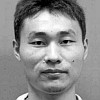 
Zhi-Zhong Chen,
Fei Deng and
Lusheng Wang. Simultaneous Identification of Duplications, Losses, and Lateral Gene Transfers. In TCBB, Vol. 9(5):1515-1528, 2012.
Keywords: duplication, explicit network, FPT, from rooted trees, from species tree, lateral gene transfer, loss, phylogenetic network, phylogeny, reconstruction.
Note: http://www.cs.cityu.edu.hk/~lwang/research/tcbb2012c.pdf.
Toggle abstract
"We give a fixed-parameter algorithm for the problem of enumerating all minimum-cost LCA-reconciliations involving gene duplications, gene losses, and lateral gene transfers (LGTs) for a given species tree S and a given gene tree G. Our algorithm can work for the weighted version of the problem, where the costs of a gene duplication, a gene loss, and an LGT are left to the user's discretion. The algorithm runs in O(m+3 k/c n) time, where m is the number of vertices in S, n is the number of vertices in G, c is the smaller between a gene duplication cost and an LGT cost, and k is the minimum cost of an LCA-reconciliation between S and G. The time complexity is indeed better if the cost of a gene loss is greater than 0. In particular, when the cost of a gene loss is at least 0.614c, the running time of the algorithm is O(m+2.78 k/cn). © 2004-2012 IEEE."
|
|
| |

Juan Wang. A new algorithm to construct phylogenetic networks from trees. In Genetics and Molecular Research, Vol. 13(1):1456-1464, 2014.
Keywords: explicit network, from clusters, heuristic, phylogenetic network, Program LNetwork, Program QuickCass, reconstruction.
Note: http://dx.doi.org/10.4238/2014.March.6.4.
Toggle abstract
"Developing appropriate methods for constructing phylogenetic networks from tree sets is an important problem, and much research is currently being undertaken in this area. BIMLR is an algorithm that constructs phylogenetic networks from tree sets. The algorithm can construct a much simpler network than other available methods. Here, we introduce an improved version of the BIMLR algorithm, QuickCass. QuickCass changes the selection strategy of the labels of leaves below the reticulate nodes, i.e., the nodes with an indegree of at least 2 in BIMLR. We show that QuickCass can construct simpler phylogenetic networks than BIMLR. Furthermore, we show that QuickCass is a polynomial-time algorithm when the output network that is constructed by QuickCass is binary. © FUNPEC-RP."
|
|
| |
  
Matthieu Willems,
Nadia Tahiri and
Vladimir Makarenkov. A new efficient algorithm for inferring explicit hybridization networks following the Neighbor-Joining principle. In JBCB, Vol. 12(5), 2014.
Keywords: explicit network, from distances, heuristic, phylogenetic network, phylogeny, reconstruction.
Toggle abstract
"Several algorithms and software have been developed for inferring phylogenetic trees. However, there exist some biological phenomena such as hybridization, recombination, or horizontal gene transfer which cannot be represented by a tree topology. We need to use phylogenetic networks to adequately represent these important evolutionary mechanisms. In this article, we present a new efficient heuristic algorithm for inferring hybridization networks from evolutionary distance matrices between species. The famous Neighbor-Joining concept and the least-squares criterion are used for building networks. At each step of the algorithm, before joining two given nodes, we check if a hybridization event could be related to one of them or to both of them. The proposed algorithm finds the exact tree solution when the considered distance matrix is a tree metric (i.e. it is representable by a unique phylogenetic tree). It also provides very good hybrids recovery rates for large trees (with 32 and 64 leaves in our simulations) for both distance and sequence types of data. The results yielded by the new algorithm for real and simulated datasets are illustrated and discussed in detail. © Imperial College Press."
|
|
| |
   
Katharina Huber,
Leo van Iersel,
Vincent Moulton and
Taoyang Wu. How much information is needed to infer reticulate evolutionary histories? In Systematic Biology, Vol. 64(1):102-111, 2015.
Keywords: explicit network, from network, from rooted trees, from subnetworks, from trinets, identifiability, phylogenetic network, phylogeny, reconstruction, uniqueness.
Note: http://dx.doi.org/10.1093/sysbio/syu076.
|
|
| |
   
Katharina Huber,
Vincent Moulton,
Mike Steel and
Taoyang Wu. Folding and unfolding phylogenetic trees and networks. In JOMB, Vol. 73(6):1761-1780, 2016.
Keywords: compressed network, explicit network, FU-stable network, NP complete, phylogenetic network, phylogeny, tree containment, tree sibling network.
Note: http://arxiv.org/abs/1506.04438.
|
|
| |
|
| |
|
| |
   
Steven Kelk,
Leo van Iersel,
Celine Scornavacca and
Mathias Weller. Phylogenetic incongruence through the lens of Monadic Second Order logic. In JGAA, Vol. 20(2):189-215, 2016.
Keywords: agreement forest, explicit network, FPT, from rooted trees, hybridization, minimum number, MSOL, phylogenetic network, phylogeny, reconstruction.
Note: http://jgaa.info/accepted/2016/KelkIerselScornavaccaWeller2016.20.2.pdf.
|
|
| |
    
Katharina Huber,
Leo van Iersel,
Vincent Moulton,
Celine Scornavacca and
Taoyang Wu. Reconstructing phylogenetic level-1 networks from nondense binet and trinet sets. In ALG, Vol. 77(1):173-200, 2017.
Keywords: explicit network, FPT, from binets, from subnetworks, from trinets, NP complete, phylogenetic network, phylogeny, polynomial, reconstruction.
Note: http://arxiv.org/abs/1411.6804.
|
|
| |
|
| |
|
| |
|
| |
|
| |
 
Sajad Mirzaei and
Yufeng Wu. Fast Construction of Near Parsimonious Hybridization Networks for Multiple Phylogenetic Trees. In TCBB, Vol. 13(3):565-570, 2016.
Keywords: bound, explicit network, from rooted trees, heuristic, phylogenetic network, phylogeny, Program PIRN, reconstruction, software.
Note: http://www.engr.uconn.edu/~ywu/Papers/PIRNs-preprint.pdf.
|
|
| |

Benjamin Albrecht. Computing all hybridization networks for multiple binary phylogenetic input trees. In BMCB, Vol. 16(236):1-15, 2015.
Keywords: agreement forest, explicit network, exponential algorithm, FPT, from rooted trees, phylogenetic network, phylogeny, Program Hybroscale, Program PIRN, reconstruction.
Note: http://dx.doi.org/10.1186/s12859-015-0660-7.
|
|
| |
|
| |
|
| |
|
| |
   
Vincent Ranwez,
Celine Scornavacca,
Jean-Philippe Doyon and
Vincent Berry. Inferring gene duplications, transfers and losses can be done in a discrete framework. In JOMB, Vol. 72(7):1811-1844, 2016.
Keywords: duplication, explicit network, from rooted trees, from species tree, lateral gene transfer, loss, phylogenetic network, phylogeny, reconstruction.
|
|
| |
|
| |
|
| |
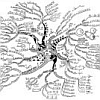   
Adrià Alcalà Mena,
Mercè Llabrés,
Francesc Rosselló and
Pau Rullan. Tree-Child Cluster Networks. In Fundamenta Informaticae, Vol. 134(1-2):1-15, 2014.
Keywords: explicit network, from clusters, phylogenetic network, phylogeny, Program PhyloNetwork, reconstruction, tree-child network.
|
|
| |
  
Sha Zhu,
James H. Degnan,
Sharyn J. Goldstein and
Bjarki Eldon. Hybrid-Lambda: simulation of multiple merger and Kingman gene genealogies in species networks and species trees. In BMCB, Vol. 16(292):1-7, 2015.
Keywords: explicit network, from network, phylogenetic network, phylogeny, Program Hybrid-Lambda, simulation, software.
Note: http://dx.doi.org/10.1186/s12859-015-0721-y.
|
|
| |
 
Marc Thuillard and
Didier Fraix-Burnet. Phylogenetic Trees and Networks Reduce to Phylogenies on Binary States: Does It Furnish an Explanation to the Robustness of Phylogenetic Trees against Lateral Transfers? In Evolutionary Bioinformatics, Vol. 11:213-221, 2015. [Abstract]
Keywords: circular split system, explicit network, from multistate characters, outerplanar, perfect, phylogenetic network, phylogeny, planar, polynomial, reconstruction, split.
Note: http://dx.doi.org/10.4137%2FEBO.S28158.
|
|
| |
    
François Chevenet,
Jean-Philippe Doyon,
Celine Scornavacca,
Edwin Jacox,
Emmanuelle Jousselin and
Vincent Berry. SylvX: a viewer for phylogenetic tree reconciliations. In BIO, Vol. 32(4):608-610, 2016.
Keywords: duplication, explicit network, from rooted trees, from species tree, lateral gene transfer, loss, phylogenetic network, phylogeny, Program SylvX, software, visualization.
Note: https://www.researchgate.net/profile/Emmanuelle_Jousselin/publication/283446016_SylvX_a_viewer_for_phylogenetic_tree_reconciliations/links/5642146108aec448fa621efa.pdf.
|
|
| |
|
| |
|
| |
|
| |
  
Philippe Gambette,
Katharina Huber and
Guillaume Scholz. Uprooted Phylogenetic Networks. In BMB, Vol. 79(9):2022-2048, 2017.
Keywords: circular split system, explicit network, from splits, galled tree, phylogenetic network, phylogeny, polynomial, reconstruction, split network, uniqueness.
Note: http://arxiv.org/abs/1511.08387.
|
|
| |

Maria Anaya,
Olga Anipchenko-Ulaj,
Aisha Ashfaq,
Joyce Chiu,
Mahedi Kaiser,
Max Shoji Ohsawa,
Megan Owen,
Ella Pavlechko,
Katherine St. John,
Shivam Suleria,
Keith Thompson and
Corrine Yap. On Determining if Tree-based Networks Contain Fixed Trees. In BMB, Vol. 78(5):961-969, 2016.
Keywords: explicit network, FPT, NP complete, phylogenetic network, phylogeny, tree-based network.
Note: http://arxiv.org/abs/1602.02739.
|
|
| |
|
| |
    
Julia Matsieva,
Steven Kelk,
Celine Scornavacca,
Chris Whidden and
Dan Gusfield. A Resolution of the Static Formulation Question for the Problem of Computing the History Bound. In TCBB, Vol. 14(2):404-417, 2017.
Keywords: ARG, explicit network, from sequences, minimum number, phylogenetic network, phylogeny.
|
|
| |
  
Gabriel Cardona,
Joan Carles Pons and
Francesc Rosselló. A reconstruction problem for a class of phylogenetic networks with lateral gene transfers. In ALMOB, Vol. 10(28):1-15, 2015.
Keywords: explicit network, from rooted trees, lateral gene transfer, phylogenetic network, phylogeny, Program LGTnetwork, reconstruction, software, tree-based network.
Note: http://dx.doi.org/10.1186/s13015-015-0059-z.
|
|
| |
   
James Oldman,
Taoyang Wu,
Leo van Iersel and
Vincent Moulton. TriLoNet: Piecing together small networks to reconstruct reticulate evolutionary histories. In MBE, Vol. 33(8):2151-2162, 2016.
Keywords: explicit network, from subnetworks, from trinets, galled tree, phylogenetic network, phylogeny, Program LEV1ATHAN, Program TriLoNet, reconstruction.
|
|
| |
|
| |
    
Philippe Gambette,
Leo van Iersel,
Steven Kelk,
Fabio Pardi and
Celine Scornavacca. Do branch lengths help to locate a tree in a phylogenetic network? In BMB, Vol. 78(9):1773-1795, 2016.
Keywords: branch length, explicit network, FPT, from network, from rooted trees, NP complete, phylogenetic network, phylogeny, pseudo-polynomial, time consistent network, tree containment, tree sibling network.
Note: http://arxiv.org/abs/1607.06285.
|
|
| |
   
Leo van Iersel,
Steven Kelk,
Giorgios Stamoulis,
Leen Stougie and
Olivier Boes. On unrooted and root-uncertain variants of several well-known phylogenetic network problems. In ALG, Vol. 80(11):2993-3022, 2018.
Keywords: explicit network, FPT, from network, from unrooted trees, NP complete, phylogenetic network, phylogeny, reconstruction, tree containment.
Note: https://hal.inria.fr/hal-01599716.
|
|
| |
 
Sha Zhu and
James H. Degnan. Displayed Trees Do Not Determine Distinguishability Under the Network Multispecies Coalescent. In SB, Vol. 66(2):283-298, 2017.
Keywords: branch length, coalescent, explicit network, from network, likelihood, phylogenetic network, phylogeny, Program Hybrid-coal, Program Hybrid-Lambda, Program PhyloNet, software, uniqueness.
Note: presentation available at https://www.youtube.com/watch?v=JLYGTfEZG7g.
|
|
| |
|
| |
  
Andreas Gunawan,
Bhaskar DasGupta and
Louxin Zhang. A decomposition theorem and two algorithms for reticulation-visible networks. In Information and Computation, Vol. 252:161-175, 2017.
Keywords: cluster containment, explicit network, from clusters, from network, from rooted trees, phylogenetic network, phylogeny, polynomial, reticulation-visible network, tree containment.
Note: https://www.cs.uic.edu/~dasgupta/resume/publ/papers/Infor_Comput_IC4848_final.pdf.
|
|
| |

Juan Wang. A Survey of Methods for Constructing Rooted Phylogenetic Networks. In PLoS ONE, Vol. 11(11):e0165834, 2016.
Keywords: evaluation, explicit network, from clusters, phylogenetic network, phylogeny, Program BIMLR, Program Dendroscope, Program LNetwork, reconstruction, survey.
Note: http://dx.doi.org/10.1371/journal.pone.0165834.
|
|
| |
|
| |
|
| |
  
Andrew R. Francis,
Katharina Huber and
Vincent Moulton. Tree-based unrooted phylogenetic networks. In BMB, Vol. 80(2):404-416, 2018.
Keywords: characterization, explicit network, NP complete, phylogenetic network, phylogeny, tree containment, tree-based network, unrooted tree-based network.
Note: https://arxiv.org/abs/1704.02062.
|
|
| |
|
| |
|
| |
  
Magnus Bordewich,
Simone Linz and
Charles Semple. Lost in space? Generalising subtree prune and regraft to spaces of phylogenetic networks. In JTB, Vol. 423:1-12, 2017.
Keywords: distance between networks, explicit network, phylogenetic network, phylogeny, reticulation-visible network, SPR distance, tree-based network, tree-child network.
Note: https://simonelinz.files.wordpress.com/2017/04/bls171.pdf.
|
|
| |
  
Magnus Bordewich,
Charles Semple and
Nihan Tokac. Constructing tree-child networks from distance matrices. In Algorithmica, Vol. 80(8):2240-2259, 2018.
Keywords: compressed network, explicit network, from distances, phylogenetic network, phylogeny, polynomial, reconstruction, tree-child network, uniqueness.
Note: http://www.math.canterbury.ac.nz/~c.semple/papers/BSN17.pdf.
|
|
| |
  
Leo van Iersel,
Steven Kelk and
Celine Scornavacca. Kernelizations for the hybridization number problem on multiple nonbinary trees. In JCSS, Vol. 82(6):1075-1089, 2016.
Keywords: explicit network, from rooted trees, kernelization, minimum number, phylogenetic network, phylogeny, Program Treeduce, reconstruction.
Note: https://arxiv.org/abs/1311.4045v3.
|
|
| |
  
Celine Scornavacca,
Joan Carles Pons and
Gabriel Cardona. Fast algorithm for the reconciliation of gene trees and LGT networks. In JTB, Vol. 418:129-137, 2017.
Keywords: duplication, explicit network, from network, from rooted trees, lateral gene transfer, LGT network, loss, parsimony, phylogenetic network, phylogeny, polynomial, reconstruction.
|
|
| |
  
Leo van Iersel,
Vincent Moulton,
Eveline De Swart and
Taoyang Wu. Binets: fundamental building blocks for phylogenetic networks. In BMB, Vol. 79(5):1135-1154, 2017.
Keywords: approximation, explicit network, from binets, from subnetworks, galled tree, level k phylogenetic network, NP complete, phylogenetic network, phylogeny, reconstruction.
Note: http://dx.doi.org/10.1007/s11538-017-0275-4.
|
|
| |
    
Philippe Gambette,
Andreas Gunawan,
Anthony Labarre,
Stéphane Vialette and
Louxin Zhang. Solving the Tree Containment Problem in Linear Time for Nearly Stable Phylogenetic Networks. In DAM, Vol. 246:62-79, 2018.
Keywords: explicit network, from network, from rooted trees, nearly-stable network, phylogenetic network, phylogeny, polynomial, tree containment.
Note: https://hal-upec-upem.archives-ouvertes.fr/hal-01575001/en/.
|
|
| |
     
Philippe Gambette,
Leo van Iersel,
Mark Jones,
Manuel Lafond,
Fabio Pardi and
Celine Scornavacca. Rearrangement Moves on Rooted Phylogenetic Networks. In PLoS Computational Biology, Vol. 13(8):e1005611.1-21, 2017.
Keywords: distance between networks, explicit network, from network, NNI distance, NNI moves, phylogenetic network, phylogeny, SPR distance.
Note: https://hal-upec-upem.archives-ouvertes.fr/hal-01572624/en/.
|
|
| |
|
| |
    
Remie Janssen,
Mark Jones,
Péter L. Erdös,
Leo van Iersel and
Celine Scornavacca. Exploring the tiers of rooted phylogenetic network space using tail moves. In BMB, Vol. 80(8):2177-2208, 2018.
Keywords: distance between networks, explicit network, from network, NNI moves, orientation, phylogenetic network, phylogeny, SPR distance.
Note: https://arxiv.org/abs/1708.07656.
|
|
| |
  
Joan Carles Pons,
Charles Semple and
Mike Steel. Tree-based networks: characterisations, metrics, and support trees. In JOMB, Vol. 78(4):899-918, 2019.
Keywords: characterization, explicit network, from network, phylogenetic network, phylogeny, time consistent network, tree-based network.
Note: https://arxiv.org/abs/1710.07836.
|
|
| |
   
Katharina Huber,
Vincent Moulton,
Charles Semple and
Taoyang Wu. Quarnet inference rules for level-1 networks. In BMB, Vol. 80:2137-2153, 2018.
Keywords: explicit network, from quarnets, from subnetworks, galled tree, level k phylogenetic network, phylogenetic network, phylogeny, reconstruction.
Note: https://arxiv.org/abs/1711.06720.
|
|
| |
|
| |
|
| |
|
| |
|
| |
|
| |
|
| |
|
| |
 
Janosch Döcker and
Simone Linz. On the existence of a cherry-picking sequence. In TCS, Vol. 714:36-50, 2018.
Keywords: cherry-picking, explicit network, from rooted trees, NP complete, phylogenetic network, phylogeny, reconstruction, temporal-hybridization number, time consistent network, tree-child network.
Note: https://arxiv.org/abs/1712.04127.
|
|
| |
|
| |
  
Leo van Iersel,
Mark Jones and
Celine Scornavacca. Improved maximum parsimony models for phylogenetic networks. In SB, Vol. 67(3):518-542, 2018.
Keywords: explicit network, FPT, from sequences, NP complete, parsimony, phylogenetic network, phylogeny, reconstruction, weakly displaying.
Note: https://leovaniersel.files.wordpress.com/2017/12/improved_parsimony_networks.pdf.
|
|
| |
|
| |
   
Janosch Döcker,
Leo van Iersel,
Steven Kelk and
Simone Linz. Deciding the existence of a cherry-picking sequence is hard on two trees. In DAM, Vol. 260:131-143, 2019.
Keywords: cherry-picking, explicit network, hybridization, minimum number, NP complete, phylogenetic network, phylogeny, reconstruction, temporal-hybridization number, time consistent network, tree-child network.
Note: https://arxiv.org/abs/1712.02965.
|
|
| |
|
| |
   
Magnus Bordewich,
Katharina Huber,
Vincent Moulton and
Charles Semple. Recovering normal networks from shortest inter-taxa distance information. In JOMB, Vol. 77(3):571-594, 2018.
Keywords: explicit network, from distances, normal network, phylogenetic network, phylogeny, polynomial, reconstruction, uniqueness.
Note: http://www.math.canterbury.ac.nz/~c.semple/papers/BHMS18.pdf.
|
|
| |
   
Chi Zhang,
Huw A. Ogilvie,
Alexei J. Drummond and
Tanja Stadler. Bayesian Inference of Species Networks from Multilocus Sequence Data. In MBE, Vol. 35(2):504-517, 2018.
Keywords: bayesian, explicit network, from sequences, phylogenetic network, phylogeny, reconstruction, statistical model.
Note: https://dx.doi.org/10.1093/molbev/msx307.
|
|
| |
  
Edwin Jacox,
Cédric Chauve,
Gergely J. Szöllösi,
Yann Ponty and
Celine Scornavacca. EcceTERA: comprehensive gene tree-species tree reconciliation using parsimony. In BIO, Vol. 32(13):2056-2058, 2016.
Keywords: duplication, explicit network, from rooted trees, from species tree, lateral gene transfer, loss, parsimony, phylogenetic network, phylogeny, polynomial, Program ecceTERA.
Note: https://doi.org/10.1093/bioinformatics/btw105.
|
|
| |
   
Edwin Jacox,
Mathias Weller,
Eric Tannier and
Celine Scornavacca. Resolution and reconciliation of non-binary gene trees with transfers, duplications and losses. In BIO, Vol. 33(7):980-987, 2017.
Keywords: duplication, explicit network, FPT, from rooted trees, from species tree, lateral gene transfer, loss, phylogenetic network, phylogeny, reconstruction.
Note: http://dx.doi.org/10.1093/bioinformatics/btw778.
|
|
| |
|
| |
|
| |
|
| |
|
| |
 
Andreas Gunawan,
Hongwei Yan and
Louxin Zhang. Compression of Phylogenetic Networks and Algorithm for the Tree Containment Problem. In JCB, Vol. 25(3), 2019.
Keywords: explicit network, phylogenetic network, phylogeny, polynomial, quasi-reticulation-visible network, reticulation-visible network, tree containment, tree-child network.
Note: https://arxiv.org/abs/1806.07625.
|
|
| |
  
Jiafan Zhu,
Dingqiao Wen,
Yun Yu,
Heidi M. Meudt and
Luay Nakhleh. Bayesian inference of phylogenetic networks from bi-allelic genetic markers. In PLoS Computational Biology, Vol. 14(1):e1005932.1-32, 2018.
Keywords: bayesian, explicit network, from multistate characters, phylogenetic network, phylogeny, Program PhyloNet.
Note: https://doi.org/10.1371/journal.pcbi.1005932.
|
|
| |
|
| |
 
Gabriel Cardona and
Louxin Zhang. Counting and Enumerating Tree-Child Networks and Their Subclasses. In JCSS, Vol. 114:84-104, 2020.
Keywords: counting, enumeration, explicit network, galled network, galled tree, normal network, phylogenetic network, phylogeny, tree-child network.
|
|
| |
|
| |
|
| |
|
| |
|
| |
 
Juan Wang and
Maozu Guo. A review of metrics measuring dissimilarity for rooted phylogenetic networks. In Briefings in Bioinformatics, Vol. 20(6):1972-1980, 2019.
Keywords: distance between networks, explicit network, from network, mu distance, phylogenetic network, phylogeny, survey, tree sibling network, tree-child network.
|
|
| |
|
| |
|
| |
|
| |
|
| |
 
Hadi Poormohammadi,
Mohsen Sardari Zarchi and
Hossein Ghaneai. NCHB: A method for constructing rooted phylogenetic networks from rooted triplets based on height function and binarization. In JTB, Vol. 489(110144), 2020.
Keywords: explicit network, from triplets, heuristic, phylogenetic network, phylogeny, Program Simplistic, Program TripNet, reconstruction.
Note: https://doi.org/10.1016/j.jtbi.2019.110144.
|
|
| |
|
| |
  
Gabriel Cardona,
Joan Carles Pons and
Celine Scornavacca. Generation of Binary Tree-Child phylogenetic networks. In PLoS Computational Biology, Vol. 15(10):e1007440.1-29, 2019.
Keywords: enumeration, explicit network, generation, phylogenetic network, phylogeny, Program PhyloNetwork, Program TCGenerators, software, tree-child network.
Note: https://doi.org/10.1371/journal.pcbi.1007440.
|
|
|
|
| |
|
| |
|
| |
     
Leo van Iersel,
Judith Keijsper,
Steven Kelk,
Leen Stougie,
Ferry Hagen and
Teun Boekhout. Constructing level-2 phylogenetic networks from triplets. In RECOMB08, Vol. 4955:450-462 of LNCS, springer, 2008.
Keywords: explicit network, from triplets, level k phylogenetic network, NP complete, phylogenetic network, phylogeny, polynomial, Program Level2, reconstruction.
Note: http://homepages.cwi.nl/~iersel/level2full.pdf. An appendix with proofs can be found here http://arxiv.org/abs/0707.2890.
Toggle abstract
"Jansson and Sung showed that, given a dense set of input triplets T (representing hypotheses about the local evolutionary relationships of triplets of taxa), it is possible to determine in polynomial time whether there exists a level-1 network consistent with T, and if so, to construct such a network [24]. Here, we extend this work by showing that this problem is even polynomial time solvable for the construction of level-2 networks. This shows that, assuming density, it is tractable to construct plausible evolutionary histories from input triplets even when such histories are heavily nontree-like. This further strengthens the case for the use of triplet-based methods in the construction of phylogenetic networks. We also implemented the algorithm and applied it to yeast data. © 2009 IEEE."
|
|
| |
 
Jesper Jansson and
Wing-Kin Sung. Inferring a level-1 phylogenetic network from a dense set of rooted triplets. In COCOON04, Vol. 3106:462-471 of LNCS, springer, 2004.
Keywords: explicit network, from triplets, galled tree, level k phylogenetic network, phylogenetic network, phylogeny, polynomial, reconstruction.
Note: http://www.df.lth.se/~jj/Publications/ipnrt6_COCOON2004.pdf.
|
|
| |
  
Jesper Jansson,
Nguyen Bao Nguyen and
Wing-Kin Sung. Algorithms for Combining Rooted Triplets into a Galled Phylogenetic Network. In SODA05, Pages 349-358, 2005.
Keywords: approximation, explicit network, from triplets, galled tree, phylogenetic network, phylogeny, polynomial, reconstruction.
Note: http://portal.acm.org/citation.cfm?id=1070481.
|
|
| |
|
| |
   
Cuong Than,
Derek Ruths,
Hideki Innan and
Luay Nakhleh. Identifiability Issues in Phylogeny-Based Detection of Horizontal Gene Transfer. In Proceedings of the Fourth RECOMB Comparative Genomics Satellite Workshop (RECOMB-CG'06), Vol. 4205:215-229 of LNCS, springer, 2006.
Keywords: explicit network, from rooted trees, from species tree, lateral gene transfer, phylogenetic network, phylogeny, Program LatTrans, Program PhyloNet.
Note: http://www.cs.rice.edu/~nakhleh/Papers/recombcg06-final.pdf.
|
|
| |
|
| |
  
Mike Hallett,
Jens Lagergren and
Ali Tofigh. Simultaneous Identification of Duplications and Lateral Transfers. In RECOMB04, Pages 347-356, 2004.
Keywords: duplication, explicit network, FPT, from rooted trees, from species tree, lateral gene transfer, loss, NP complete, parsimony, phylogenetic network, phylogeny, polynomial, reconstruction.
Note: http://www.nada.kth.se/~jensl/p164-hallett.pdf.
|
|
| |
 
Leo van Iersel and
Steven Kelk. Constructing the Simplest Possible Phylogenetic Network from Triplets. In ISAAC08, Vol. 5369:472-483 of LNCS, springer, 2008.
Keywords: explicit network, from triplets, galled tree, level k phylogenetic network, minimum number, phylogenetic network, phylogeny, polynomial, Program Marlon, Program Simplistic.
Note: http://arxiv.org/abs/0805.1859.
|
|
| |
 
Sagi Snir and
Tamir Tuller. Novel Phylogenetic Network Inference by Combining Maximum Likelihood and Hidden Markov Models. In WABI08, Vol. 5251:354-368 of LNCS, springer, 2008.
Keywords: explicit network, from sequences, HMM, lateral gene transfer, likelihood, phylogenetic network, phylogeny, statistical model.
Note: http://dx.doi.org/10.1007/978-3-540-87361-7_30.
Toggle abstract
"Horizontal Gene Transfer (HGT) is the event of transferring genetic material from one lineage in the evolutionary tree to a different lineage. HGT plays a major role in bacterial genome diversification and is a significant mechanism by which bacteria develop resistance to antibiotics. Although the prevailing assumption is of complete HGT, cases of partial HGT (which are also named chimeric HGT) where only part of a gene is horizontally transferred, have also been reported, albeit less frequently. In this work we suggest a new probabilistic model for analyzing and modeling phylogenetic networks, the NET-HMM. This new model captures the biologically realistic assumption that neighboring sites of DNA or amino acid sequences are not independent, which increases the accuracy of the inference. The model describes the phylogenetic network as a Hidden Markov Model (HMM), where each hidden state is related to one of the network's trees. One of the advantages of the NET-HMM is its ability to infer partial HGT as well as complete HGT. We describe the properties of the NET-HMM, devise efficient algorithms for solving a set of problems related to it, and implement them in software. We also provide a novel complementary significance test for evaluating the fitness of a model (NET-HMM) to a given data set. Using NET-HMM we are able to answer interesting biological questions, such as inferring the length of partial HGT's and the affected nucleotides in the genomic sequences, as well as inferring the exact location of HGT events along the tree branches. These advantages are demonstrated through the analysis of synthetical inputs and two different biological inputs. © 2008 Springer-Verlag Berlin Heidelberg."
|
|
| |
 
Ernst Althaus and
Rouven Naujoks. Reconstructing Phylogenetic Networks with One Recombination. In Proceedings of the seventh International Workshop on Experimental Algorithms (WEA'08), Vol. 5038:275-288 of LNCS, springer, 2008.
Keywords: enumeration, explicit network, exponential algorithm, from sequences, generation, parsimony, phylogenetic network, phylogeny, reconstruction, unicyclic network.
Note: http://dx.doi.org/10.1007/978-3-540-68552-4_21.
Toggle abstract
"In this paper we propose a new method for reconstructing phylogenetic networks under the assumption that recombination events have occurred rarely. For a fixed number of recombinations, we give a generalization of the maximum parsimony criterion. Furthermore, we describe an exact algorithm for one recombination event and show that in this case our method is not only able to identify the recombined sequence but also to reliably reconstruct the complete evolutionary history. © 2008 Springer-Verlag Berlin Heidelberg."
|
|
| |
  
Cuong Than,
Guohua Jin and
Luay Nakhleh. Integrating Sequence and Topology for Efficient and Accurate Detection of Horizontal Gene Transfer. In Proceedings of the Sixth RECOMB Comparative Genomics Satellite Workshop (RECOMB-CG'08), Vol. 5267:113-127 of LNCS, springer, 2008.
Keywords: bootstrap, explicit network, from rooted trees, from sequences, lateral gene transfer, phylogenetic network, phylogeny, Program Nepal, Program PhyloNet, reconstruction.
Note: http://www.cs.rice.edu/~nakhleh/Papers/recombcg-08.pdf, slides available at http://igm.univ-mlv.fr/RCG08/RCG08slides/Cuong_Than_RCG08.pdf.
|
|
| |

Pawel Górecki. Reconciliation problems for duplication, loss and horizontal gene transfer. In RECOMB04, Pages 316-325, 2004.
Keywords: duplication, explicit network, from rooted trees, from species tree, lateral gene transfer, loss, NP complete, parsimony, phylogenetic network, phylogeny, polynomial, reconstruction.
Note: http://ai.stanford.edu/~serafim/CS374_2004/Papers/Gorecki_Reconciliation.pdf.
|
|
| |

Pawel Górecki. Single step reconciliation algorithm for duplication, loss and horizontal gene transfer model. In ECCB03, 2003.
Keywords: duplication, explicit network, from rooted trees, from species tree, lateral gene transfer, NP complete, parsimony, phylogenetic network, phylogeny, polynomial, reconstruction.
Note: http://www.inra.fr/eccb2003/posters/pdf/short/S_gorecki.ps.
|
|
| |
  
Bin Ma,
Lusheng Wang and
Ming Li. Fixed topology alignment with recombination. In CPM98, Vol. 1448:174-188 of LNCS, springer, 1998.
Keywords: approximation, explicit network, from network, from sequences, galled tree, inapproximability, phylogenetic network, phylogeny, recombination.
Note: http://dx.doi.org/10.1007/BFb0030789.
|
|
| |
 
Thu-Hien To and
Michel Habib. Level-k Phylogenetic Networks Are Constructable from a Dense Triplet Set in Polynomial Time. In CPM09, (5577):275-288, springer, 2009.
Keywords: explicit network, from triplets, level k phylogenetic network, minimum number, phylogenetic network, phylogeny, polynomial, reconstruction.
Note: http://arxiv.org/abs/0901.1657.
Toggle abstract
"For a given dense triplet set Τ there exist two natural questions [7]: Does there exist any phylogenetic network consistent with Τ? In case such networks exist, can we find an effective algorithm to construct one? For cases of networks of levels k = 0, 1 or 2, these questions were answered in [1,6,7,8,10] with effective polynomial algorithms. For higher levels k, partial answers were recently obtained in [11] with an O(/Τ/k+1)time algorithm for simple networks. In this paper, we give a complete answer to the general case, solving a problem proposed in [7]. The main idea of our proof is to use a special property of SN-sets in a level-k network. As a consequence, for any fixed k, we can also find a level-k network with the minimum number of reticulations, if one exists, in polynomial time. © 2009 Springer Berlin Heidelberg."
|
|
| |
  
Philippe Gambette,
Vincent Berry and
Christophe Paul. The structure of level-k phylogenetic networks. In CPM09, Vol. 5577:289-300 of LNCS, springer, 2009.
Keywords: coalescent, explicit network, galled tree, level k phylogenetic network, phylogenetic network, Program Recodon.
Note: http://hal-lirmm.ccsd.cnrs.fr/lirmm-00371485/en/.
Toggle abstract
"Evolution is usually described as a phylogenetic tree, but due to some exchange of genetic material, it can be represented as a phylogenetic network which has an underlying tree structure. The notion of level was recently introduced as a parameter on realistic kinds of phylogenetic networks to express their complexity and tree-likeness. We study the structure of level-k networks, and how they can be decomposed into level-k generators. We also provide a polynomial time algorithm which takes as input the set of level-k generators and builds the set of level-(k + 1) generators. Finally, with a simulation study, we evaluate the proportion of level-k phylogenetic networks among networks generated according to the coalescent model with recombination. © 2009 Springer Berlin Heidelberg."
|
|
| |
    
Daniel H. Huson,
Regula Rupp,
Vincent Berry,
Philippe Gambette and
Christophe Paul. Computing Galled Networks from Real Data. In ISMBECCB09, Vol. 25(12):i85-i93 of BIO, 2009.
Keywords: abstract network, cluster containment, explicit network, FPT, from clusters, from rooted trees, galled network, NP complete, phylogenetic network, phylogeny, polynomial, Program Dendroscope, reconstruction.
Note: http://hal-lirmm.ccsd.cnrs.fr/lirmm-00368545/en/.
Toggle abstract
"Motivation: Developing methods for computing phylogenetic networks from biological data is an important problem posed by molecular evolution and much work is currently being undertaken in this area. Although promising approaches exist, there are no tools available that biologists could easily and routinely use to compute rooted phylogenetic networks on real datasets containing tens or hundreds of taxa. Biologists are interested in clades, i.e. groups of monophyletic taxa, and these are usually represented by clusters in a rooted phylogenetic tree. The problem of computing an optimal rooted phylogenetic network from a set of clusters, is hard, in general. Indeed, even the problem of just determining whether a given network contains a given cluster is hard. Hence, some researchers have focused on topologically restricted classes of networks, such as galled trees and level-k networks, that are more tractable, but have the practical draw-back that a given set of clusters will usually not possess such a representation. Results: In this article, we argue that galled networks (a generalization of galled trees) provide a good trade-off between level of generality and tractability. Any set of clusters can be represented by some galled network and the question whether a cluster is contained in such a network is easy to solve. Although the computation of an optimal galled network involves successively solving instances of two different NP-complete problems, in practice our algorithm solves this problem exactly on large datasets containing hundreds of taxa and many reticulations in seconds, as illustrated by a dataset containing 279 prokaryotes. © 2009 The Author(s)."
|
|
| |
|
| |
|
| |
    
Tetsuo Asano,
Jesper Jansson,
Kunihiko Sadakane,
Ryuhei Uehara and
Gabriel Valiente. Faster Computation of the Robinson-Foulds Distance between Phylogenetic Networks. In CPM10, Vol. 6129:190-201 of LNCS, springer, 2010.
Keywords: distance between networks, explicit network, level k phylogenetic network, phylogenetic network, polynomial, spread.
Note: http://hdl.handle.net/10119/9859, slides available at http://cs.nyu.edu/parida/CPM2010/MainPage_files/18.pdf.
Toggle abstract
"The Robinson-Foulds distance, which is the most widely used metric for comparing phylogenetic trees, has recently been generalized to phylogenetic networks. Given two networks N1,N2 with n leaves, m nodes, and e edges, the Robinson-Foulds distance measures the number of clusters of descendant leaves that are not shared by N1 and N2. The fastest known algorithm for computing the Robinson-Foulds distance between those networks runs in O(m(m + e)) time. In this paper, we improve the time complexity to O(n(m+ e)/ log n) for general networks and O(nm/log n) for general networks with bounded degree, and to optimal O(m + e) time for planar phylogenetic networks and boundedlevel phylogenetic networks.We also introduce the natural concept of the minimum spread of a phylogenetic network and show how the running time of our new algorithm depends on this parameter. As an example, we prove that the minimum spread of a level-k phylogenetic network is at most k + 1, which implies that for two level-k phylogenetic networks, our algorithm runs in O((k + 1)(m + e)) time. © Springer-Verlag Berlin Heidelberg 2010."
|
|
| |

Yufeng Wu. Close Lower and Upper Bounds for the Minimum Reticulate Network of Multiple Phylogenetic Trees. In ISMB10, Vol. 26(12):i140-i148 of BIO, 2010.
Keywords: explicit network, from rooted trees, hybridization, minimum number, phylogenetic network, phylogeny, Program PIRN, software.
Note: http://dx.doi.org/10.1093/bioinformatics/btq198.
Toggle abstract
"Motivation: Reticulate network is a model for displaying and quantifying the effects of complex reticulate processes on the evolutionary history of species undergoing reticulate evolution. A central computational problem on reticulate networks is: given a set of phylogenetic trees (each for some region of the genomes), reconstruct the most parsimonious reticulate network (called the minimum reticulate network) that combines the topological information contained in the given trees. This problem is well-known to be NP-hard. Thus, existing approaches for this problem either work with only two input trees or make simplifying topological assumptions. Results: We present novel results on the minimum reticulate network problem. Unlike existing approaches, we address the fully general problem: there is no restriction on the number of trees that are input, and there is no restriction on the form of the allowed reticulate network. We present lower and upper bounds on the minimum number of reticulation events in the minimum reticulate network (and infer an approximately parsimonious reticulate network). A program called PIRN implements these methods, which also outputs a graphical representation of the inferred network. Empirical results on simulated and biological data show that our methods are practical for a wide range of data. More importantly, the lower and upper bounds match for many datasets (especially when the number of trees is small or reticulation level is low), and this allows us to solve the minimum reticulate network problem exactly for these datasets. Availability: A software tool, PIRN, is available for download from the web page: http://www.engr.uconn.edu/ywu. Contact: ywu@engr.uconn.edu. Supplementary information: Supplementary data is available at Bioinformatics online. © The Author(s) 2010. Published by Oxford University Press."
|
|
| |

Yufeng Wu and
Jiayin Wang. Fast Computation of the Exact Hybridization Number of Two Phylogenetic Trees. In ISBRA10, Vol. 6053:203-214 of LNCS, springer, 2010.
Keywords: agreement forest, explicit network, from rooted trees, hybridization, integer linear programming, minimum number, phylogenetic network, phylogeny, Program HybridNumber, Program SPRDist, SPR distance.
Note: http://www.engr.uconn.edu/~ywu/Papers/ISBRA10WuWang.pdf.
Toggle abstract
"Hybridization is a reticulate evolutionary process. An established problem on hybridization is computing the minimum number of hybridization events, called the hybridization number, needed in the evolutionary history of two phylogenetic trees. This problem is known to be NP-hard. In this paper, we present a new practical method to compute the exact hybridization number. Our approach is based on an integer linear programming formulation. Simulation results on biological and simulated datasets show that our method (as implemented in program SPRDist) is more efficient and robust than an existing method. © 2010 Springer-Verlag Berlin Heidelberg."
|
|
| |
    
Jean-Philippe Doyon,
Celine Scornavacca,
Konstantin Yu Gorbunov,
Gergely J. Szöllösi,
Vincent Ranwez and
Vincent Berry. An efficient algorithm for gene/species trees parsimonious reconciliation with losses, duplications, and transfers. In Proceedings of the Eighth RECOMB Comparative Genomics Satellite Workshop (RECOMB-CG'10), Vol. 6398:93-108 of LNCS, springer, 2011.
Keywords: branch length, duplication, dynamic programming, explicit network, from multilabeled tree, from species tree, from unrooted trees, lateral gene transfer, loss, phylogenetic network, phylogeny, polynomial, Program Mowgli, reconstruction.
Note: http://www.lirmm.fr/~vberry/Publis/MPR-DoyonEtAl.pdf, software available at http://www.atgc-montpellier.fr/MPR/.
Toggle abstract
"Tree reconciliation methods aim at estimating the evolutionary events that cause discrepancy between gene trees and species trees. We provide a discrete computational model that considers duplications, transfers and losses of genes. The model yields a fast and exact algorithm to infer time consistent and most parsimonious reconciliations. Then we study the conditions under which parsimony is able to accurately infer such events. Overall, it performs well even under realistic rates, transfers being in general less accurately recovered than duplications. An implementation is freely available at http://www.atgc- montpellier.fr/MPR. © 2010 Springer-Verlag."
|
|
| |
  
Mukul S. Bansal,
J. Peter Gogarten and
Ron Shamir. Detecting Highways of Horizontal Gene Transfer. In Proceedings of the Eighth RECOMB Comparative Genomics Satellite Workshop (RECOMB-CG'10), Vol. 6398:109-120 of LNCS, springer, 2011.
Keywords: explicit network, from rooted trees, from species tree, lateral gene transfer, phylogenetic network, phylogeny, polynomial, reconstruction.
Note: http://www.cs.iastate.edu/~bansal/Highways_RCG10.pdf.
Toggle abstract
"In a horizontal gene transfer (HGT) event a gene is transferred between two species that do not share an ancestor-descendant relationship. Typically, no more than a few genes are horizontally transferred between any two species. However, several studies identified pairs of species between which many different genes were horizontally transferred. Such a pair is said to be linked by a highway of gene sharing. We present a method for inferring such highways. Our method is based on the fact that the evolutionary histories of horizontally transferred genes disagree with the corresponding species phylogeny. Specifically, given a set of gene trees and a trusted rooted species tree, each gene tree is first decomposed into its constituent quartet trees and the quartets that are inconsistent with the species tree are identified. Our method finds a pair of species such that a highway between them explains the largest (normalized) fraction of inconsistent quartets. For a problem on n species, our method requires O(n 4) time, which is optimal with respect to the quartets input size. An application of our method to a dataset of 1128 genes from 11 cyanobacterial species, as well as to simulated datasets, illustrates the efficacy of our method. © 2010 Springer-Verlag."
|
|
| |
  
Chris Whidden,
Robert G. Beiko and
Norbert Zeh. Fast FPT Algorithms for Computing Rooted Agreement Forests: Theory and Experiments. In Proceedings of the ninth International Symposium on Experimental Algorithms (SEA'10), Vol. 6049:141-153 of LNCS, springer, 2010.
Keywords: agreement forest, explicit network, FPT, from rooted trees, hybridization, minimum number, phylogenetic network, phylogeny, Program HybridInterleave, reconstruction, SPR distance.
Note: https://www.cs.dal.ca/sites/default/files/technical_reports/CS-2010-03.pdf.
Toggle abstract
"We improve on earlier FPT algorithms for computing a rooted maximum agreement forest (MAF) or a maximum acyclic agreement forest (MAAF) of a pair of phylogenetic trees. Their sizes give the subtree-prune-and-regraft (SPR) distance and the hybridization number of the trees, respectively. We introduce new branching rules that reduce the running time of the algorithms from O(3 kn) and O(3 kn log n) to O(2.42 kn) and O(2.42 kn log n), respectively. In practice, the speed up may be much more than predicted by the worst-case analysis.We confirm this intuition experimentally by computing MAFs for simulated trees and trees inferred from protein sequence data. We show that our algorithm is orders of magnitude faster and can handle much larger trees and SPR distances than the best previous methods, treeSAT and sprdist. © Springer-Verlag Berlin Heidelberg 2010."
|
|
| |
  
Hadas Birin,
Zohar Gal-Or,
Isaac Elias and
Tamir Tuller. Inferring Models of Rearrangements, Recombinations, and Horizontal Transfers by the Minimum Evolution Criterion. In WABI07, Vol. 4645:111-123 of LNCS, springer, 2007.
Keywords: explicit network, from sequences, phylogenetic network, phylogeny, reconstruction.
Note: http://safrabio.cs.tau.ac.il/download/Papers/Birin_et_al.pdf.
|
|
| |
|
| |
 
Hyun Jung Park and
Luay Nakhleh. MURPAR: A fast heuristic for inferring parsimonious phylogenetic networks from multiple gene trees. In ISBRA12, Vol. 7292:213-224 of LNCS, springer, 2012.
Keywords: explicit network, from unrooted trees, heuristic, phylogenetic network, phylogeny, reconstruction, software.
Note: https://www.researchgate.net/profile/Hyun_Jung_Park2/publication/262318595_MURPAR_A_Fast_Heuristic_for_Inferring_Parsimonious_Phylogenetic_Networks_from_Multiple_Gene_Trees/links/54b7e7b50cf269d8cbf58cc4.pdf.
Toggle abstract
"Phylogenetic networks provide a graphical representation of evolutionary histories that involve non-treelike evolutionary events, such as horizontal gene transfer (HGT). One approach for inferring phylogenetic networks is based on reconciling gene trees, assuming all incongruence among the gene trees is due to HGT. Several mathematical results and algorithms, both exact and heuristic, have been introduced to construct and analyze phylogenetic networks. Here, we address the computational problem of inferring phylogenetic networks with minimum reticulations from a collection of gene trees. As this problem is known to be NP-hard even for a pair of gene trees, the problem at hand is very hard. In this paper, we present an efficient heuristic, MURPAR, for inferring a phylogenetic network from a collection of gene trees by using pairwise reconciliations of trees in the collection. Given the development of efficient and accurate methods for pairwise gene tree reconciliations, MURPAR inherits this efficiency and accuracy. Further, the method includes a formulation for combining pairwise reconciliations that is naturally amenable to an efficient integer linear programming (ILP) solution. We show that MURPAR produces more accurate results than other methods and is at least as fast, when run on synthetic and biological data. We believe that our method is especially important for rapidly obtaining estimates of genome-scale evolutionary histories that can be further refined by more detailed and compute-intensive methods. © 2012 Springer-Verlag."
|
|
| |
 
Pawel Górecki and
Jerzy Tiuryn. Inferring evolutionary scenarios in the duplication, loss and horizontal gene transfer model. In Logic and Program Semantics, Vol. 7230:83-105 of LNCS, springer, 2012.
Keywords: duplication, explicit network, lateral gene transfer, loss, phylogenetic network, phylogeny, reconstruction.
Note: http://dx.doi.org/10.1007/978-3-642-29485-3_7.
Toggle abstract
"An H-tree is a formal model of evolutionary scenario. It can be used to represent any processes with gene duplication and loss, horizontal gene transfer (HGT) and speciation events. The model of H-trees, introduced in [26], is an extension of the duplication-loss model (DL-model). Similarly to its ancestor, it has a number of interesting mathematical and biological properties. It is, however, more computationally complex than the DL-model. In this paper, we primarily address the problem of inferring H-trees that are compatible with a given gene tree and a given phylogeny of species with HGTs. These results create a mathematical and computational foundation for a more general and practical problem of inferring HGTs from given gene and species trees with HGTs. We also demonstrate how our model can be used to support HGT hypotheses based on empirical data sets. © 2012 Springer-Verlag Berlin Heidelberg."
|
|
| |
  
Mukul S. Bansal,
Eric J. Alm and
Manolis Kellis. Efficient Algorithms for the Reconciliation Problem with Gene Duplication, Horizontal Transfer, and Loss. In ISMB12, Vol. 28(12):i283-i291 of BIO, 2012.
Keywords: duplication, explicit network, from rooted trees, from species tree, lateral gene transfer, loss, phylogenetic network, phylogeny, Program Angst, Program Mowgli, Program RANGER-DTL, reconstruction.
Note: http://dx.doi.org/10.1093/bioinformatics/bts225.
Toggle abstract
"Motivation: Gene family evolution is driven by evolutionary events such as speciation, gene duplication, horizontal gene transfer and gene loss, and inferring these events in the evolutionary history of a given gene family is a fundamental problem in comparative and evolutionary genomics with numerous important applications. Solving this problem requires the use of a reconciliation framework, where the input consists of a gene family phylogeny and the corresponding species phylogeny, and the goal is to reconcile the two by postulating speciation, gene duplication, horizontal gene transfer and gene loss events. This reconciliation problem is referred to as duplication-transfer-loss (DTL) reconciliation and has been extensively studied in the literature. Yet, even the fastest existing algorithms for DTL reconciliation are too slow for reconciling large gene families and for use in more sophisticated applications such as gene tree or species tree reconstruction.Results: We present two new algorithms for the DTL reconciliation problem that are dramatically faster than existing algorithms, both asymptotically and in practice. We also extend the standard DTL reconciliation model by considering distance-dependent transfer costs, which allow for more accurate reconciliation and give an efficient algorithm for DTL reconciliation under this extended model. We implemented our new algorithms and demonstrated up to 100 000-fold speed-up over existing methods, using both simulated and biological datasets. This dramatic improvement makes it possible to use DTL reconciliation for performing rigorous evolutionary analyses of large gene families and enables its use in advanced reconciliation-based gene and species tree reconstruction methods. © The Author(s) 2012. Published by Oxford University Press."
|
|
| |
 
Jesper Jansson and
Andrzej Lingas. Computing the rooted triplet distance between galled trees by counting triangles. In CPM12, Vol. 7354:385-398 of LNCS, springer, 2012.
Keywords: distance between networks, explicit network, from network, galled tree, phylogenetic network, phylogeny, polynomial, triplet distance.
Note: http://www.df.lth.se/~jj/Publications/d_rt_for_Galled_Trees5_CPM_2012.pdf.
Toggle abstract
"We consider a generalization of the rooted triplet distance between two phylogenetic trees to two phylogenetic networks. We show that if each of the two given phylogenetic networks is a so-called galled tree with n leaves then the rooted triplet distance can be computed in o(n 2.688) time. Our upper bound is obtained by reducing the problem of computing the rooted triplet distance to that of counting monochromatic and almost- monochromatic triangles in an undirected, edge-colored graph. To count different types of colored triangles in a graph efficiently, we extend an existing technique based on matrix multiplication and obtain several new related results that may be of independent interest. © 2012 Springer-Verlag."
|
|
| |
   
Leo van Iersel,
Steven Kelk,
Nela Lekic and
Celine Scornavacca. A practical approximation algorithm for solving massive instances of hybridization number. In WABI12, Vol. 7534(430-440) of LNCS, springer, 2012.
Keywords: agreement forest, approximation, explicit network, from rooted trees, hybridization, phylogenetic network, phylogeny, Program CycleKiller, Program Dendroscope, Program HybridNET, reconstruction, software.
Note: http://arxiv.org/abs/1205.3417.
Toggle abstract
"Reticulate events play an important role in determining evolutionary relationships. The problem of computing the minimum number of such events to explain discordance between two phylogenetic trees is a hard computational problem. In practice, exact solvers struggle to solve instances with reticulation number larger than 40. For such instances, one has to resort to heuristics and approximation algorithms. Here we present the algorithm CycleKiller which is the first approximation algorithm that can produce solutions verifiably close to optimality for instances with hundreds or even thousands of reticulations. Theoretically, the algorithm is an exponential-time 2-approximation (or 4-approximation in its fastest mode). However, using simulations we demonstrate that in practice the algorithm runs quickly for large and difficult instances, producing solutions within one percent of optimality. An implementation of this algorithm, which extends the theoretical work of [14], has been made publicly available. © 2012 Springer-Verlag."
|
|
| |
 
Hyun Jung Park and
Luay Nakhleh. Inference of reticulate evolutionary histories by maximum likelihood:
The performance of information criteria. In RECOMB-CG'12, Vol. 13(suppl 19):S12 of BMCB, 2012.
Keywords: AIC, BIC, explicit network, heuristic, likelihood, phylogenetic network, phylogeny, reconstruction, statistical model.
Note: http://www.biomedcentral.com/1471-2105/13/S19/S12.
|
|
| |
    
Maureen Stolzer,
Han Lai,
Minli Xu,
Deepa Sathaye,
Benjamin Vernot and
Dannie Durand. Inferring Duplications, Losses, Transfers, and Incomplete Lineage Sorting with Non-Binary Species Trees. In ECCB12, Vol. 28(18):i409-i415 of BIO, 2012.
Keywords: duplication, explicit network, from rooted trees, lateral gene transfer, loss, phylogenetic network, phylogeny, Program Notung, reconstruction.
Note: http://dx.doi.org/10.1093/bioinformatics/bts386.
Toggle abstract
"Motivation: Gene duplication (D), transfer (T), loss (L) and incomplete lineage sorting (I) are crucial to the evolution of gene families and the emergence of novel functions.The history of these events can be inferred via comparison of gene and species trees, a process called reconciliation, yet current reconciliation algorithms model only a subset of these evolutionary processes. Results: We present an algorithm to reconcile a binary gene tree with a nonbinary species tree under a DTLI parsimony criterion. This is the first reconciliation algorithm to capture all four evolutionary processes driving tree incongruence and the first to reconcile nonbinary species trees with a transfer model. Our algorithm infers all optimal solutions and reports complete, temporally feasible event histories, giving the gene and species lineages in which each event occurred. It is fixed-parameter tractable, with polytime complexity when the maximum species outdegree is fixed. Application of our algorithms to prokaryotic and eukaryotic data show that use of an incomplete event model has substantial impact on the events inferred and resulting biological conclusions. © The Author(s) 2012. Published by Oxford University Press."
|
|
| |
|
| |
   
Katharina Huber,
Vincent Moulton,
Andreas Spillner,
Sabine Storandt and
Radoslaw Suchecki. Computing a consensus of multilabeled trees. In ALENEX12, Pages 84-92, 2012.
Keywords: duplication, explicit network, exponential algorithm, phylogenetic network, phylogeny.
Note: http://siam.omnibooksonline.com/2012ALENEX/data/papers/020.pdf.
Toggle abstract
In this paper we consider two challenging problems that arise in the context of computing a consensus of a collection of multilabeled trees, namely (1) selecting a compatible collection of clusters on a multiset from an ordered list of such clusters and (2) optimally refining high degree vertices in a multilabeled tree. Forming such a consensus is part of an approach to reconstruct the evolutionary history of a set of species for which events such as genome duplication and hybridization have occurred in the past. We present exact algorithms for solving (1) and (2) that have an exponential run-time in the worst case. To give some impression of their performance in practice, we apply them to simulated input and to a real biological data set highlighting the impact of several structural properties of the input on the performance.
|
|
| |

Yufeng Wu. An Algorithm for Constructing Parsimonious Hybridization Networks with Multiple Phylogenetic Trees. In RECOMB13, Vol. 7821:291-303 of LNCS, springer, 2013.
Keywords: explicit network, exponential algorithm, from rooted trees, phylogenetic network, phylogeny, Program PIRN, reconstruction.
Note: http://www.engr.uconn.edu/~ywu/Papers/ExactNetRecomb2013.pdf.
Toggle abstract
"Phylogenetic network is a model for reticulate evolution. Hybridization network is one type of phylogenetic network for a set of discordant gene trees, and "displays" each gene tree. A central computational problem on hybridization networks is: given a set of gene trees, reconstruct the minimum (i.e. most parsimonious) hybridization network that displays each given gene tree. This problem is known to be NP-hard, and existing approaches for this problem are either heuristics or make simplifying assumptions (e.g. work with only two input trees or assume some topological properties). In this paper, we develop an exact algorithm (called PIRNC ) for inferring the minimum hybridization networks from multiple gene trees. The PIRNC algorithm does not rely on structural assumptions. To the best of our knowledge, PIRN C is the first exact algorithm for this formulation. When the number of reticulation events is relatively small (say four or fewer), PIRNC runs reasonably efficient even for moderately large datasets. For building more complex networks, we also develop a heuristic version of PIRNC called PIRNCH. Simulation shows that PIRNCH usually produces networks with fewer reticulation events than those by an existing method. © 2013 Springer-Verlag."
|
|
| |
 
Leo van Iersel and
Steven Kelk. Kernelizations for the hybridization number problem on multiple nonbinary trees. In WG14, Vol. 8747:299-311 of LNCS, springer, 2014.
Keywords: explicit network, from rooted trees, kernelization, minimum number, phylogenetic network, phylogeny, Program Treeduce, reconstruction.
Note: http://arxiv.org/abs/1311.4045.
|
|
| |
 
Chris Whidden and
Norbert Zeh. A Unifying View on Approximation and FPT of Agreement Forests. In WABI09, Vol. 5724:390-402 of LNCS, Springer, 2009.
Keywords: agreement forest, approximation, explicit network, FPT, minimum number, phylogenetic network, phylogeny, reconstruction.
Note: https://www.cs.dal.ca/sites/default/files/technical_reports/CS-2009-02.pdf.
Toggle abstract
"We provide a unifying view on the structure of maximum (acyclic) agreement forests of rooted and unrooted phylogenies. This enables us to obtain linear- or O(n log n)-time 3-approximation and improved fixed-parameter algorithms for the subtree prune and regraft distance between two rooted phylogenies, the tree bisection and reconnection distance between two unrooted phylogenies, and the hybridization number of two rooted phylogenies. © 2009 Springer Berlin Heidelberg."
|
|
| |
   
Louxin Zhang,
Yen Kaow Ng,
Taoyang Wu and
Yu Zheng. Network model and efficient method for detecting relative duplications or horizontal gene transfers. In ICCABS11, Pages 214-219, 2011.
Keywords: dynamic programming, explicit network, from network, from rooted trees, from species tree, phylogenetic network, phylogeny, polynomial, reconstruction.
Toggle abstract
"Background: Horizontal gene transfer and gene duplication are two significant forces behind genome evolution. As more and more well-supported examples of HGTs are being revealed, there is a growing awareness that HGT is more widespread than previously thought, occurring often not only within bacteria, but also between species remotely related such as bacteria and plants or plants and animals. Although a substantial number of genomic sequences are known, HGT inference remains challenging. Parsimony-based inferences of HGT events are typically NP-hard under the framework of gene tree and species tree comparison; it is even more timeconsuming if the maximum likelihood approach is used. The fact that gene tree and species tree incongruence can be further confounded by gene duplication and gene loss events motivates us to incorporate considerations for these events into our inference of HGT events. Similarly, it will be beneficial if known HGT events are considered in the inference of gene duplications and gene losses. © 2011 IEEE."
|
|
| |
    
Philippe Gambette,
Andreas Gunawan,
Anthony Labarre,
Stéphane Vialette and
Louxin Zhang. Locating a Tree in A Phylogenetic Network in Quadratic Time. In RECOMB15, Vol. 9029:96-107 of LNCS, Springer, 2015.
Keywords: evaluation, explicit network, from network, from rooted trees, genetically stable network, nearly-stable network, phylogenetic network, phylogeny, polynomial, tree containment.
Note: https://hal.archives-ouvertes.fr/hal-01116231/en.
|
|
| |
|
| |
 
Quan Nguyen and
Teemu Roos. Likelihood-based inference of phylogenetic networks from sequence data by PhyloDAG. In AlCoB15, Vol. 9199:126-140 of LNCS, springer, 2015.
Keywords: BIC, explicit network, from sequences, likelihood, phylogenetic network, phylogeny, Program PhyloDAG, reconstruction, software.
Note: http://www.cs.helsinki.fi/u/ttonteri/pub/alcob2015.pdf.
|
|
| |
|
| |
  
Jittat Fakcharoenphol,
Tanee Kumpijit and
Attakorn Putwattana. A Faster Algorithm for the Tree Containment Problem for Binary Nearly Stable Phylogenetic Networks. In Proceedings of the The 12th International Joint Conference on Computer Science and Software Engineering (JCSSE'15), Pages 337-342, IEEE, 2015.
Keywords: dynamic programming, explicit network, from network, from rooted trees, nearly-stable network, phylogenetic network, phylogeny, polynomial, tree containment.
|
|
| |
  
Andreas Gunawan,
Bhaskar DasGupta and
Louxin Zhang. Locating a Tree in a Reticulation-Visible Network in Cubic Time. In RECOMB16, Vol. 9649:266 of LNBI, Springer, 2016.
Keywords: cluster containment, explicit network, from clusters, from network, from rooted trees, phylogenetic network, phylogeny, polynomial, reticulation-visible network, tree containment.
Note: http://arxiv.org/abs/1507.02119.
|
|
| |
 
Yun Yu and
Luay Nakhleh. A Distance-Based Method for Inferring Phylogenetic Networks in the Presence of Incomplete Lineage Sorting. In ISBRA15, Vol. 9096:378-389 of LNCS, springer, 2015.
Keywords: bootstrap, explicit network, from distances, heuristic, incomplete lineage sorting, phylogenetic network, phylogeny, reconstruction.
Note: http://bioinfo.cs.rice.edu/sites/bioinfo.cs.rice.edu/files/YuNakhleh-ISBRA15.pdf.
|
|
| |
    
Philippe Gambette,
Andreas Gunawan,
Anthony Labarre,
Stéphane Vialette and
Louxin Zhang. Solving the Tree Containment Problem for Genetically Stable Networks in Quadratic Time. In IWOCA15, Vol. 9538:197-208 of LNCS, springer, 2016.
Keywords: explicit network, from network, from rooted trees, genetically stable network, phylogenetic network, phylogeny, polynomial, tree containment.
Note: https://hal-upec-upem.archives-ouvertes.fr/hal-01226035 .
|
|
| |
 
Yun Yu and
Luay Nakhleh. A maximum pseudo-likelihood approach for phylogenetic networks. In RECOMB-CG15, Vol. 16(Suppl 10)(S10):1-10 of BMC Genomics, BioMed Central, 2015.
Keywords: explicit network, from rooted trees, hybridization, incomplete lineage sorting, likelihood, phylogenetic network, phylogeny, Program PhyloNet, reconstruction, tripartition distance.
Note: http://dx.doi.org/10.1186/1471-2164-16-S10-S10.
|
|
| |
|
| |
|
| |
 
Jiafan Zhu,
Yun Yu and
Luay Nakhleh. In the Light of Deep Coalescence: Revisiting Trees Within Networks. In RECOMB-CG16, Vol. 17(suppl. 14):415.271-282 of BMCB, 2016.
Keywords: branch length, evaluation, explicit network, incomplete lineage sorting, phylogenetic network, phylogeny, statistical model, tree-based network, weakly displaying.
Note: http://arxiv.org/abs/1606.07350.
|
|
| |
|
| |

Mathias Weller. Linear-Time Tree Containment in Phylogenetic Networks. In RECOMB-CG18, Vol. 11183:309-323 of LNCS, Springer, 2018.
Keywords: explicit network, from network, from rooted trees, nearly-stable network, phylogenetic network, phylogeny, polynomial, reconstruction, reticulation-visible network, tree containment.
Note: https://arxiv.org/abs/1702.06364.
|
|
| |
   
Hussein A. Hejase,
Natalie VandePol,
Gregory A. Bonito and
Kevin J. Liu. Fast and accurate statistical inference of phylogenetic networks using large-scale genomic sequence data. In RECOMB-CG18, Vol. 11183:242-259 of LNCS, Springer, 2018.
Keywords: explicit network, from rooted trees, heuristic, phylogenetic network, phylogeny, Program FastNet, reconstruction.
Note: http://biorxiv.org/content/early/2017/05/01/132795.
|
|
| |
  
Bingxin Lu,
Louxin Zhang and
Hon Wai Leong. A program to compute the soft Robinson-Foulds distance between phylogenetic networks. In APBC17, Vol. 18(Suppl. 2):111 of BMC Genomics, 2017.
Keywords: cluster containment, distance between networks, explicit network, exponential algorithm, from network, phylogenetic network, phylogeny, Program icelu-PhyloNetwork.
Note: http://dx.doi.org/10.1186/s12864-017-3500-5.
|
|
| |

Andreas Gunawan. Solving the Tree Containment Problem for Reticulation-visible Networks in Linear Time. In AlCoB18, Vol. 10849:24-36 of LNCS, Springer, 2018.
Keywords: explicit network, from network, from rooted trees, phylogenetic network, phylogeny, polynomial, reticulation-visible network, tree containment.
Note: https://arxiv.org/abs/1702.04088.
|
|
| |
  
Han Lai,
Maureen Stolzer and
Dannie Durand. Fast Heuristics for Resolving Weakly Supported Branches Using Duplication, Transfers, and Losses. In RECOMB-CG17, Vol. 10562:298-320 of LNCS, Springer, 2017.
Keywords: duplication, explicit network, from rooted trees, from species tree, lateral gene transfer, loss, phylogenetic network, phylogeny, Program Notung, reconstruction.
|
|
| |
  
Kuang-Yu Chang,
Yun Cui,
Siu-Ming Yiu and
Wing-Kai Hon. Reconstructing One-Articulated Networks with Distance Matrices. In ISBRA17, Vol. 10330:34-45 of LNCS, Springer, 2017.
Keywords: explicit network, from distances, k-reticulated, phylogenetic network, phylogeny, reconstruction.
Note: https://link.springer.com/content/pdf/10.1007%2F978-3-319-59575-7.pdf#page=100.
|
|
| |
|
| |
 
Juan Wang and
Maozu Guo. IGNet: Constructing Rooted Phylogenetic Networks Based on Incompatible Graphs. In ICNC-FSKD19, Vol. 1075:894-900 of Advances in Intelligent Systems and Computing, Springer, 2019.
Keywords: explicit network, from rooted trees, phylogenetic network, phylogeny, Program BIMLR, Program IGNet, Program LNetwork, reconstruction, software.
|
|
| |
  
Remie Janssen,
Mark Jones and
Yukihiro Murakami. Combining Networks Using Cherry Picking Sequences. In AlCoB20, Vol. 12099:77-92 of LNCS, Springer, 2020.
Keywords: cherry-picking, explicit network, FPT, from network, hybridization, orchard network, phylogenetic network, phylogeny, tree-child network.
|
|
| |
 
Remie Janssen and
Yukihiro Murakami. Linear Time Algorithm for Tree-Child Network Containment. In AlCoB20, Vol. 12099:93-107 of LNCS, Springer, 2020.
Keywords: explicit network, from network, isomorphism, phylogenetic network, phylogeny, polynomial, reconstruction, tree-child network, tree-child sequence.
Note: https://doi.org/10.1007/978-3-030-42266-0_8.
|
|
|
|
 - forked on GitHub.
- forked on GitHub.

































































































































































































































